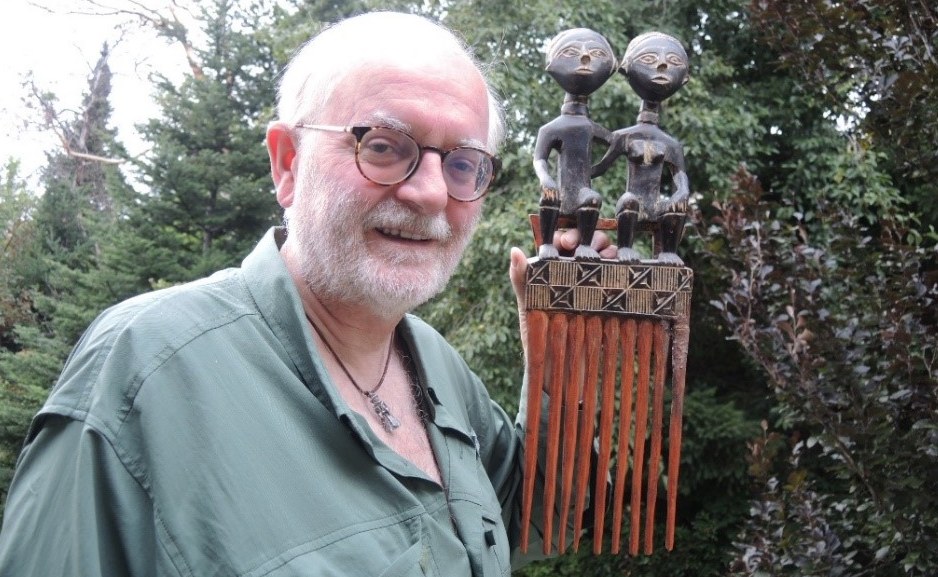By Grant Keddie.
Preface
Combs are artifacts used by many cultures around the world over thousands of years. They are used primarily for disentangling and arranging the hair, but also as decorative items for holding the hair and head pieces, they have evolved into symbols of status or authority and cultural identity. To make a point, I show an extreme physical example of an Ashanti comb from Ghana in figure 1. Large Ashanti prestige combs were given by men to women as an act of devotion and commitment. In the 1970s, African combs took on a role in African American culture and politics where they became a sign of solidarity to the Black Power movement as a cultural statement.
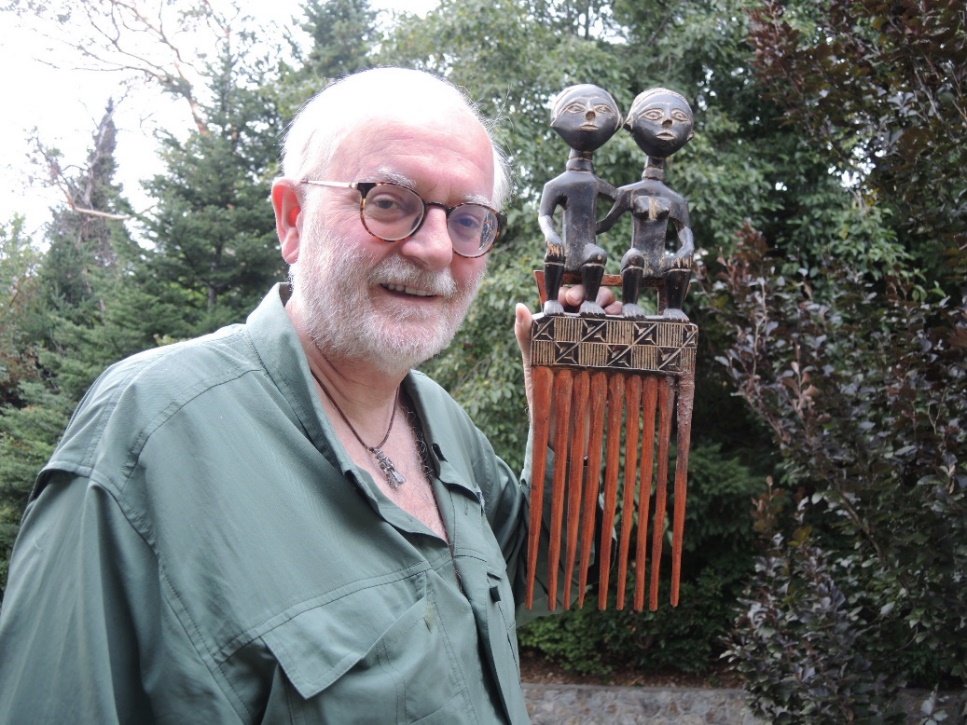
Combs tell us about human behavior. Tracing their history tells us about changes in and connections within and between human societies.
The English word comb came from the proto-Germanic word Kambijana which means “to comb”. As in other Indigenous languages it is a verb, an action word that implies the brushing of something through the air. It has now mostly become a noun referring to a shape rather than an action – even though it is used for objects that have different actions. In English the word is also used to describe physical shapes such as the fleshy red crest on the head of a domestic fowl, one of the pair of organs on the base of the abdomen in scorpions, the top of a gun stock or the toothed plates on an escalator.
What kinds of shifts in the presence and function of combs that may have occurred among the Indigenous cultures of British Columbia will be a topic that future archaeologists can build upon as new evidence becomes available. There is a bigger story waiting to be told.
Introduction
There is a general impression that Indigenous combs are items that are common and well known about. If fact, a minimal amount of the ethnographic and archaeological literature deals with combs in any detail.
What we call combs, however, serve other purposes. They are used for processing plant fibers, gathering berries and removing parasites like flees and lice. There are head and paint scratching combs, as well as for combs for holding and decorating the hair of humans and possibly for combing or carding the hair of mountain goats. They may have been used in compressing the weft strings in weaving. The existence of tattoo combs is still uncertain. There is the question of how one can tell the difference between these and other items such as hairpins?
In the discussion part, I will examine what we have leaned from the study of combs in this and other parts of the world and how it may contribute to the identification of different types of combs found on the Northwest Coast.
Figure 2, is a comb that resembles a Sxwayxwey mask used on the southern coast of British Columbia. Its symbolism was likely of importance and its use restricted to those families that had the rights to the Sxwayxwey ceremonies. It was donated to the British Museum in the 1860s without detailed information.

As early as the 1790s, Indigenous artists saw business opportunities by making objects that would appeal to the crews of European ships. They carved combs with men wearing European style top hats. These were not the older traditional artifacts used in the local cultures, but items carved for the purposes of trade.
Changes in the 19th century that appealed to European purchasers included examples like that shown in figure 3.

The Royal B.C. Museum Indigenous Collection
What I will examine here are those items in the indigenous collections of the Royal B.C. Museum and other museum collections that mostly have a flat main body part called a shaft, usually rectangular to square or V-shaped, that has sets of teeth on either one or two sides. These include artifacts that may have been attached and/or unattached to the hair and those that may have had other functions such as working fibres or used as a parasite comb. There are also two examples of what are called paint scratcher combs found in the Interior of British Columbia that I will include here. I will not include obvious non-Indigenous manufactured combs and non-traditional combs or more recent copies of traditional combs made as modern art.
I will examine both the ethnographic and archaeological Indigenous collections in the RBCM and bring in examples from other museums to expand upon suppositions about the use and iconography of these collections. In Appendix 1, I will examine combs from the Perth Museum, which I have determined are not from the Northwest coast.
Some combs in RBCM ethnographic collections are actually of an archaeological nature but ended up getting placed in the ethnographic collection – usually because they were artistic and in good condition. Of the thirteen ethnographic combs in the RBCM collection described here, one is definitely of an archaeological nature and two are most likely from an archaeological context. It is important to show that these latter examples are not to be considered historic ethnological artifacts that can be compared to archaeological combs for the purpose of understanding changes through time.
Before I proceed with the description of Museum combs, I will provide an overview of the ethnographic literature. There are many areas of the province of B.C. where there are no, or very few, museum examples of combs. In these cases, we need to depend on the written sources to reconstruct the past use of combs.
An Overview of the Ethnographic Sources
There are rare cases where combs are recorded in Indigenous mythology. In one story the hero throws his comb from a canoe on to the mountains between Alert Bay and Knight Inlet where it is transformed into trees (Boas 1916).
The ethnological information on combs is rather sparse for many areas of British Columbia or lacking in detail. Indigenous languages show distinctions between different kinds of named combs and hair attachments. In the North Straits Salish language, for example, there are separate words for hair pin, comb, fine toothed comb and dancers comb (Montler 1991). Separate words for comb and fine-toothed comb also occur in Hul’q’umi’num’, but their uses are not specified (Gerdts 1997).
Combs can be used for combing hair in either a day-to-day use or have a ceremonial use. In some cases, they are used only to hold the hair in place or to have a decorative purpose with a symbolic function, beyond hair combing, such as the that seen on the comb in figure 2. Combs were used as head scratchers in puberty ceremonies (fig. 6). Some were used to process plant fibre and material for weaving and possibly in some areas to compress the weft fibres in weaving. There is minimal documentation on the latter uses in British Columbia. The identification of possible tattoo combs vs hair combs is another subject that will be examined.
Hair styles and the use of hair ornaments was important in the reflection of status within Northwest Coast societies. The role of combs in these activities is in need of more elaboration.
Anthropologist Philip Drucker recorded the information about girls’ hairstyles done in preparation for their puberty or coming of age ceremonies. His Indigenous consultants were among the northern and central Nuu-chah-nulth on the west coast of Vancouver Island:
“There were two types of hair ornaments, one called ai’aitshm, a single unit suspended at the back of the head and which was usually reserved for the eldest daughter of a family, and the other, hûhûpistkum, which consisted of two parts, worn of each side. For the former, the girl’s hair was combed back tightly and done up in one braid at the nape of her neck. The end of the braid was doubled up underneath over a wooden pin 3 or 4 inches long. The double braid was wrapped with a string of coloured beads.
The hair ornament itself consisted of a row of strings of dentalia shells a span wide spread out flat by means of two or three wooden spreaders wrap-twined in place. At the upper end, the strands, which might be 2 or 3 feet long, were woven or knotted together, with two long free ends for tying the ornament to the base of the doubled braid just above the wooden pin. … A really good hair ornament, such as a chief’s daughter would wear, consisted of strands of mountain goat hair.” (Drucker 1951:139).
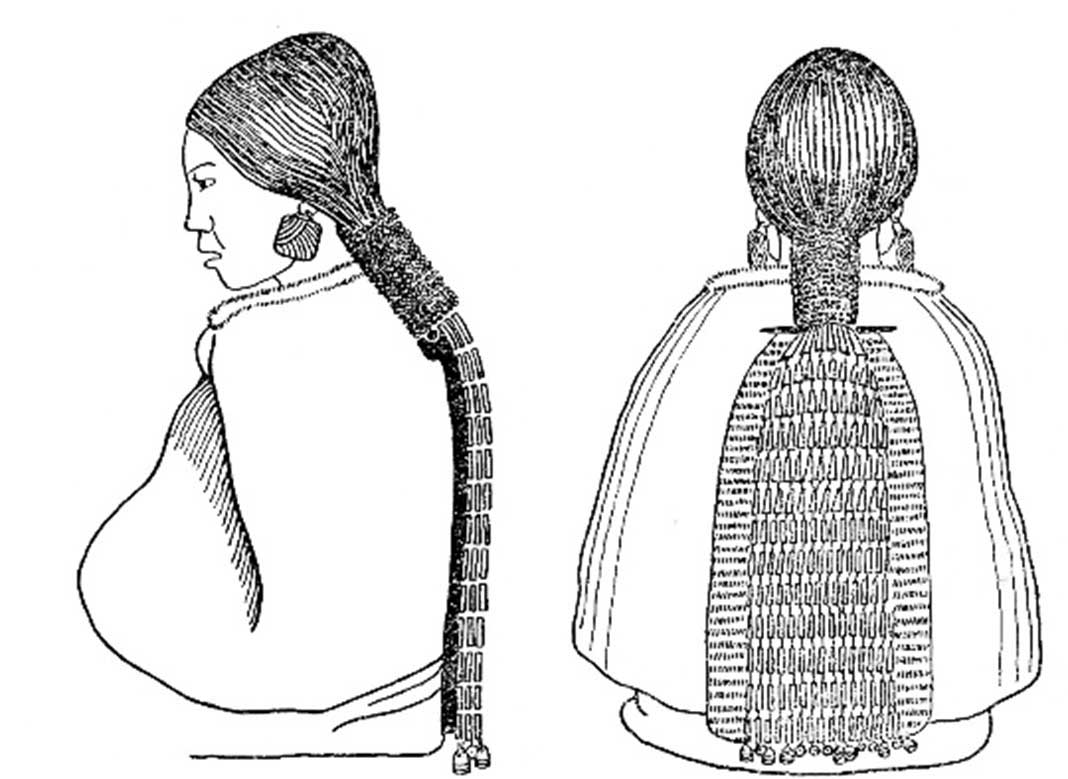
Ethnographic examples of combs are primarily made of wood and archaeological examples made of antler and wood. The species of wood is often listed in museum records but rarely identified by a professional with the appropriate knowledge. Unless it is stated they have been properly identified I will just refer to them as being made of wood.
People who dealt in purchasing ethnographic artifacts and selling them often knew that they would get more money if they were somehow connected by shamanism. One needs to be critical of these statements regarding the context of the artifacts and in interpreting the iconographic of combs.
The earliest observations and collecting of combs on the Northwest Coast cultural area was during the Cook expedition of 1778, and a few other European explorers and fur traders in the late 19th century. These are now in various European Museums (Kaeppler 1978). How the style of combs or the raw material used may have been influenced by European combs is important to examine. As early as March 6, 1860, the British Colonist was advertising commercial “horn combs” for sale at the auction of J.A. McCrea in Victoria. They were sold earlier by the Hudson’s Bay Company stores.
Sarah Stone drew some of the combs collected on the Cook expedition of 1778. One seen in figure 5 resembles a modern-day flea comb.
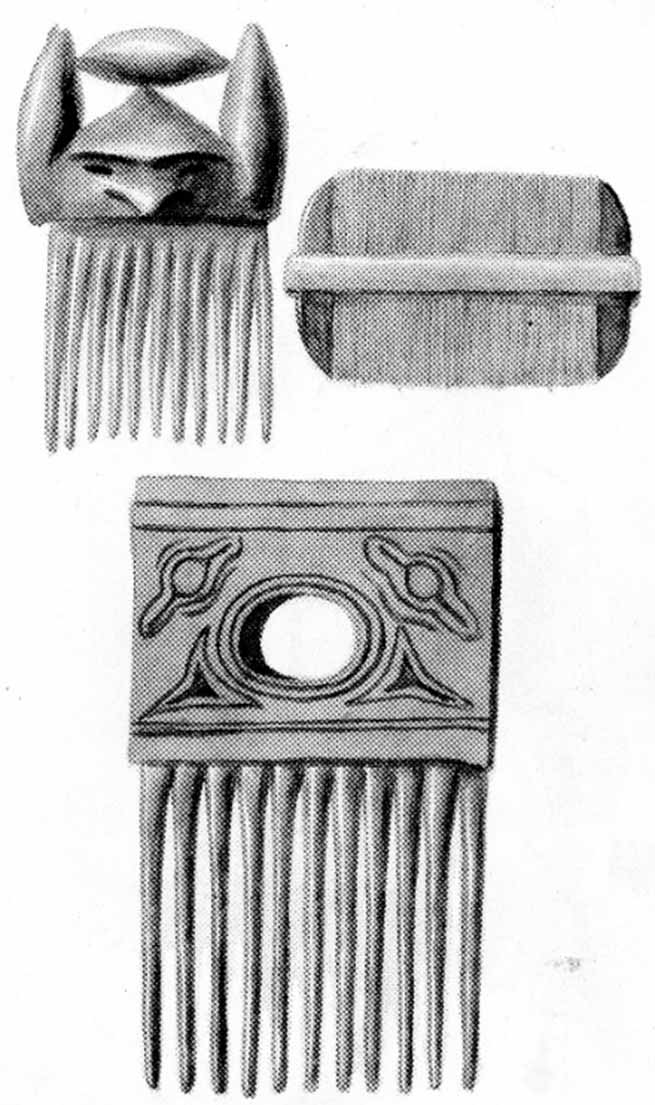
Combs of the Southern Coast of B.C. and Northwestern Washington
Writing in the early 20th century, Edward Curtis provided information of how combs are made as well as other uses of combs:
“Combs are still made of flat pieces of very dry, hard yew by scratching with a sharp bone awl, first on one side and then on the other, deep, closely set flutings, which meeting from opposite sides, form a set of thin teeth. This implement is about five inches long and three inches wide [127x76mm], with teeth about two inches long [50mm], and it is used not only to comb the hair but to separate nettle fibres from the cellular portion of the stalk and to card the hair of mountain goats.” (Curtis 1913:65)
In discussing the use of nettle fibre as warp strands in robe manufacture Curtis notes:
“The nettle stalks were first split and hung up to dry, and then gently beaten with a club. Held in clusters by the ends they were combed with a fine-toothed yew instrument until all the pith and the woody substance were gone and only the fine, strong filaments left.” (Curtis 1913:44).
There is a suggestion here that at least one type of comb was used for processing nettle. In the latter circumstance the size of the width between the teeth of the comb would be important. In my own experiments I found that comb teeth that were wider apart worked best. Thinly spaced teeth tended to get clogged with nettle.
Boas had earlier mentioned that when nettle was dry: “they were peeled and the fibres were combed out” (Boas 1890). This would refer to the separation of the bast fibre or outer stalk of the nettle.
They were cut in October, split lengthwise with a bone needle, and dried for five or six days outside, and then over a fire (Goddard, 1924).
Paul Kane observed among the Lekwungen in 1847, that in weaving the weft thread it is “carried by the hand, and pressed closely together by a sort of wooden comb” (Lister 2016).
Hair Combing and Puberty Combs
Barnett documented hair combing as part of the traditional puberty ceremony on south eastern Vancouver Island. During the puberty ceremony “the girl was put on the pile of blankets and her hair was ceremonially combed by two other women who sang and used rattles. At the conclusion of the combing, all the attendants were paid”. Among the Paul family of Cowichan Bay during the last day of seclusion a girl was washed, her hair “ritually combed” and she was then provided with a wool headdress. In another family a boy received washing and hair combing. At Nanaimo hair combing was done after “washing” of the winter-dancing initiate (Barnett, 1955). Barnett, in his cultural element distributions on the Gulf of Georgia Salish, illustrates the more common comb that has eight teeth and notes they were made of yew and maple wood (Barnett 1939).
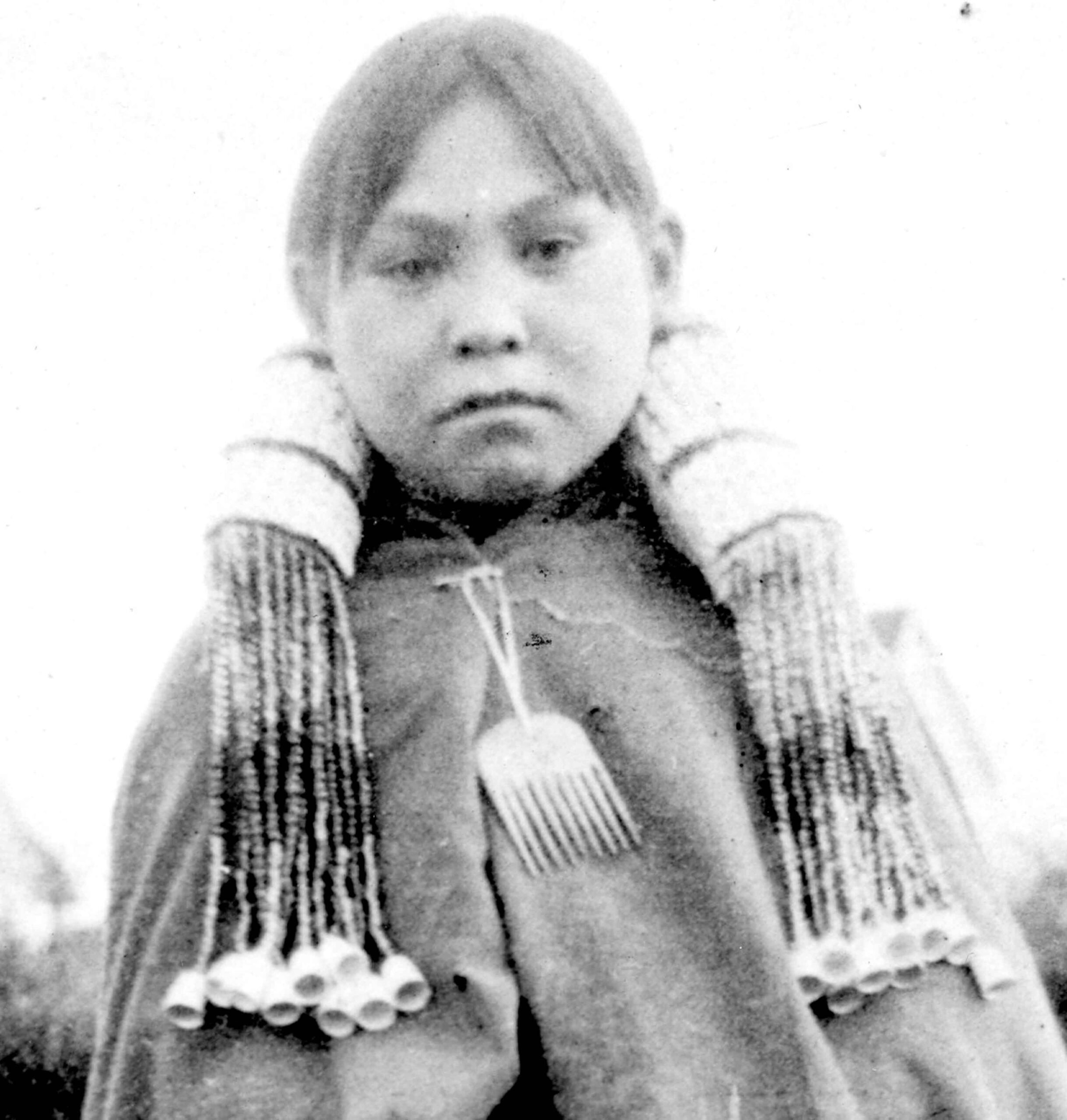
Jenness describes a Westholme, Cowichan story with details of a girl’s coming out ceremony. After many activities involving dancing the two attendants of the girl “began to sing and shake their rattles while the audience beat time with the sticks, then taking a special comb, with four preliminary feints, two toward the crown and two toward the sides of the girl’s head, they combed her hair and plaited it in two braids” (Jenness 1934).
Stern describes Lummi wooden combs with narrow central shafts and 4-6 teeth at each end for men: “Men permit their hair to grow long and after combing it usually let it hang down their back, tied with a buckskin cord at the nape of the neck. Sometimes it is rolled into a pug and held in place with a long four toothed comb” (Stern 1934:23). The suggestion here is that a longer than normal comb with only four teeth was used as a hair holder as opposed to a hair comber.
Stern describes different combs for the girls’ puberty ceremony which involves ritual hair combing:
“The women usually wear their hair in two braids which they permit to hang around their breasts while around the house, but when doing any vigorous work, they swing the braids over their backs. The ends of the braids are tied with combings. Wooden hardwood combs with five or six teeth are used” (Stern 1934).
According to Suttles (1951:267), combs were carved from syringa wood (also known as mock orange, Philadelphus lewissi). Barnett lists rectangular yew and maple wood combs for the Gulf of Georgia Salish (Barnett 1939) and he illustrates a typical specimen, which has eight teeth. He describes how: “Men cut their hair to shoulder length or parted it in the middle and caught it up with wooden pins in a knot at the back of the head. The latter style was usual for men at work or when going to war. Otherwise, long hair was unbound and fell disheveled about the face and shoulders unless a cap or fillet was worn. Women did their hair in two braids on either side of their heads from a center part. …Combs were of yew or maple and were of one piece; they had several teeth” (Barnett 1955). His figure 18, shows a “typical” comb with eight teeth that is similar to number 1993 in the RBCM collection
Waterman describes a comb-like picker for red elderberries:
“This device is made by taking a short piece of cedar wood, and splitting it down from one end, into thin strips. Cedar bark fibre is found tightly around the other end to keep the whole together. The sections or splints are then separated by driving wedges in, so that they spread apart like the fingers of the hand. Their points are then sharpened. In berry picking, the Indian breaks the elderberry bush down, pulls the branches off bodily, and piles them on a mat. Then he picks up one branch at a time and “whips” it with the implement. The operation detaches the berries, but not the branches and leaves” (Waterman 1973, pl. 34a).

Puget Sound and Olympic Peninsula.
Fur Trade goods for the Columbia River in 1824-25 included “common combs” made of horn. Three dozen went to Fort George and six dozen to Spokan House (Merk 1931). How these may have influenced local indigenous designs is unknown.
Gunther notes that shamans wore both combs and hairpins during curing ceremonies as well as when they were not practicing (Gunther 1966). They were decorated with both spirit helpers and what appears to be crest-emblems.
Among the Makah, Ells indicated that men wear their hair long “but on whaling expeditions they tie it up in a knot behind the head and: “They frequently decorate themselves by winding wreaths of evergreens around the knob or stick in a sprig of spruce with feathers or wreath of sea weed” (Ells 1986). He makes no mention of the use of combs as hair decoration.
In Puget Sound, Washington State combs: “The teeth are usually 2 ½ inches long, there being about five to the inch, though they vary. Sixteen teeth are the most I have seen on a single one, are more common than double ones.” (Eells 1985).
“The Snohomish had combs (epa’ts) of yew wood. The teeth of the comb were about three inches long, the whole comb measuring about eight inches.” (Haeberlin and Gunther 1930).
Wingert attempts to present regional styles. He sees the Skokomish (Twana) combs as a Puget Sound style. The examples from Chicago Natural History Museum no.19651, a man with a top hat, and no.19652 that has a nun-like appearance are obviously not traditional subject matter (Wingert1976). The combs shown in figure 8, were collected by Rev. Myron Eells in 1892.
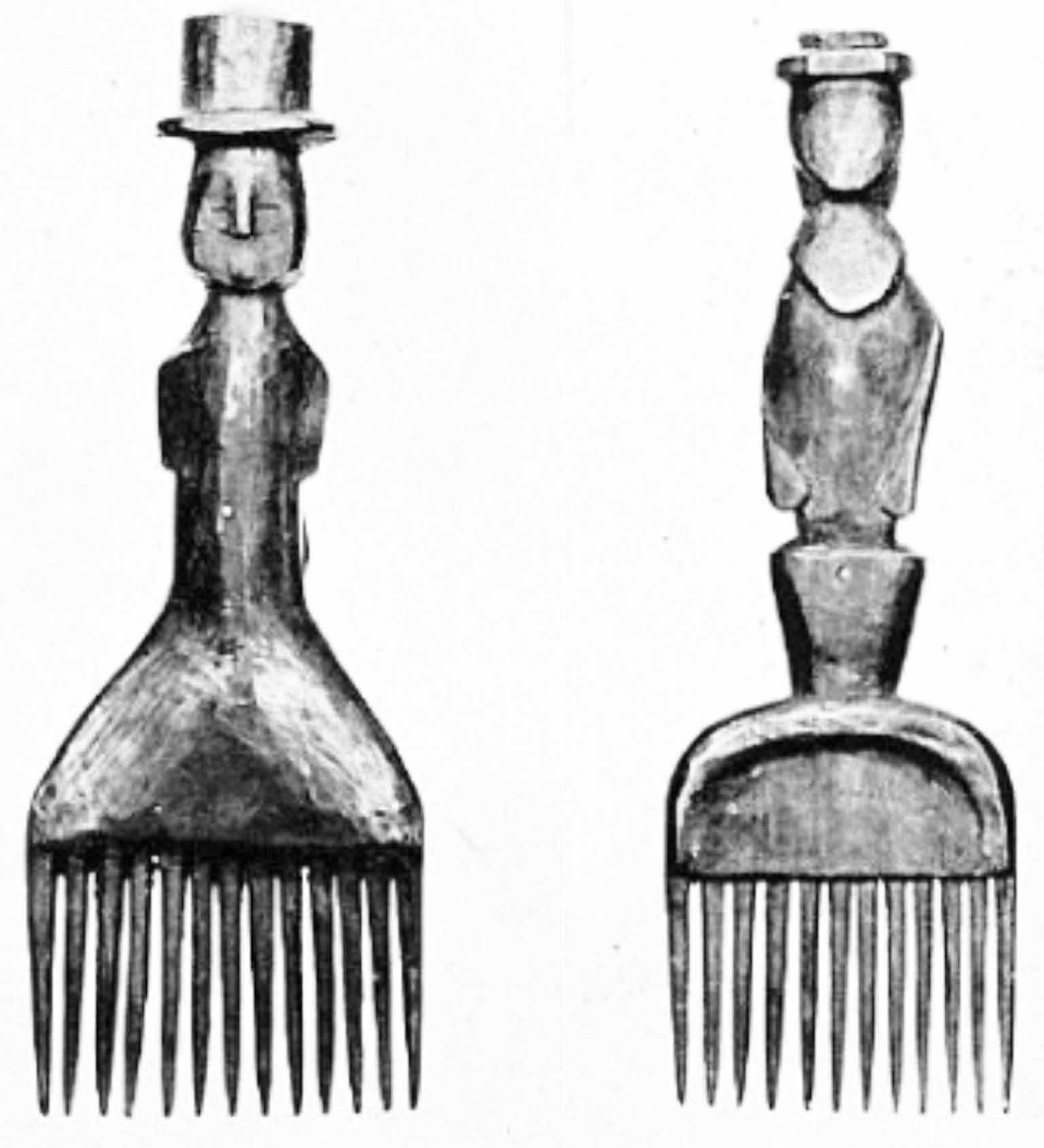
Examples of older Traditional Combs
Figure 9. shows a more traditional wood comb that was donated by Roderick McKenzie of the Hudson’s Bay Company in 1818, to the American Antiquarian Society (AAS: A. 95-20-10/48393). The record originally had “wooden comb North West Coast” but when transferred to Peabody Museum (No. 95-20-10-10/48393), added information included “Southern Vancouver [Island] or Lower Fraser” and “Representing Mythical Xoaexoe” (5.08×21.59×1.19cm). This does appear to be one of the later known four-legged lightning snake beings.

Figure 10, shows both sides of a traditional double-sided comb from the British Museum with wide spaced teeth. It has eight teeth on one side and six on the other. It was collected in 1792, by George Goodman Hewett at a village on Restoration Point on Bainbridge Island, Washington State, when on George Vancouver’s voyage to the coast from 1791-1795 (7 ½” x 2: x 13/16”).
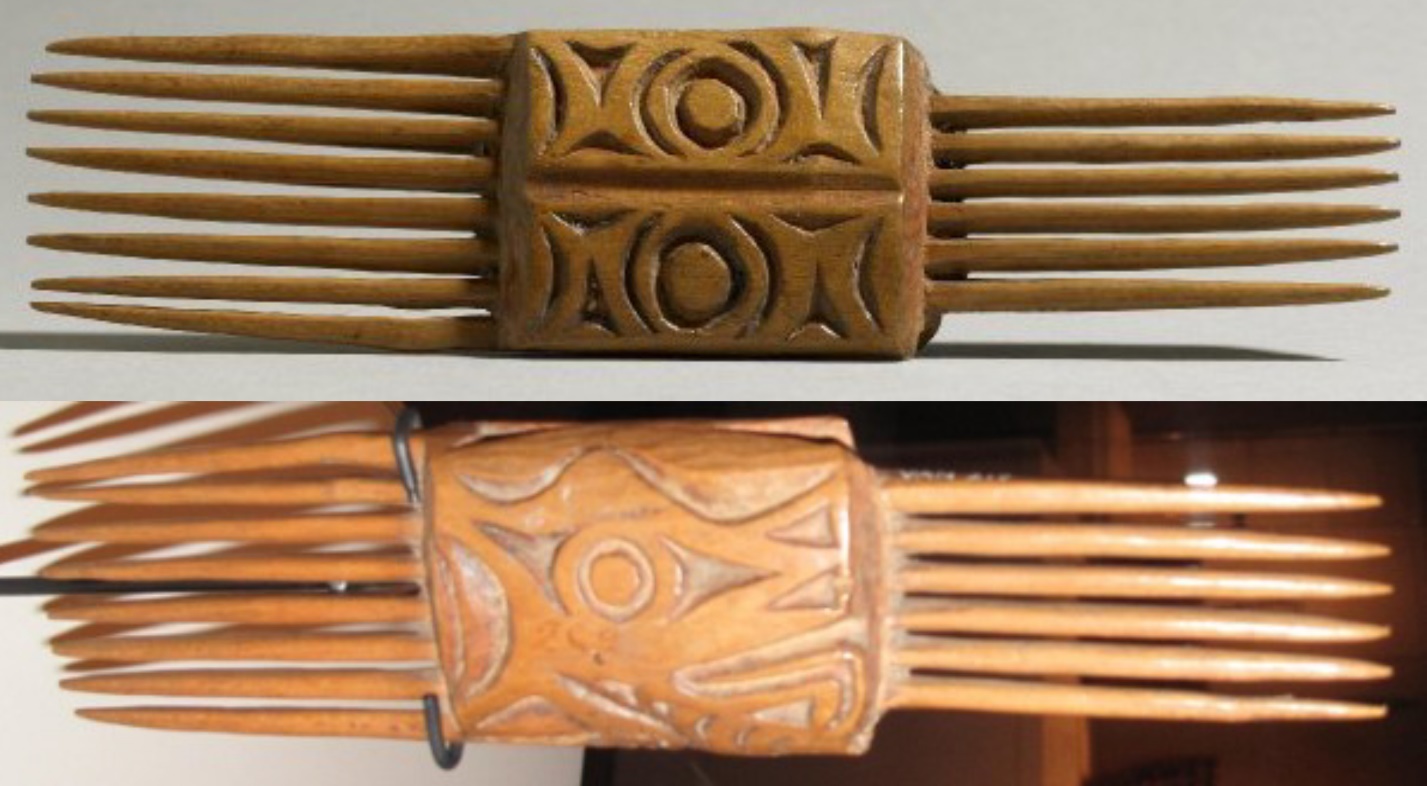
Figure 11, has ten teeth on each side (18.3cm x 6cm x 2.2cm). It was donated to the British Museum in 1860.
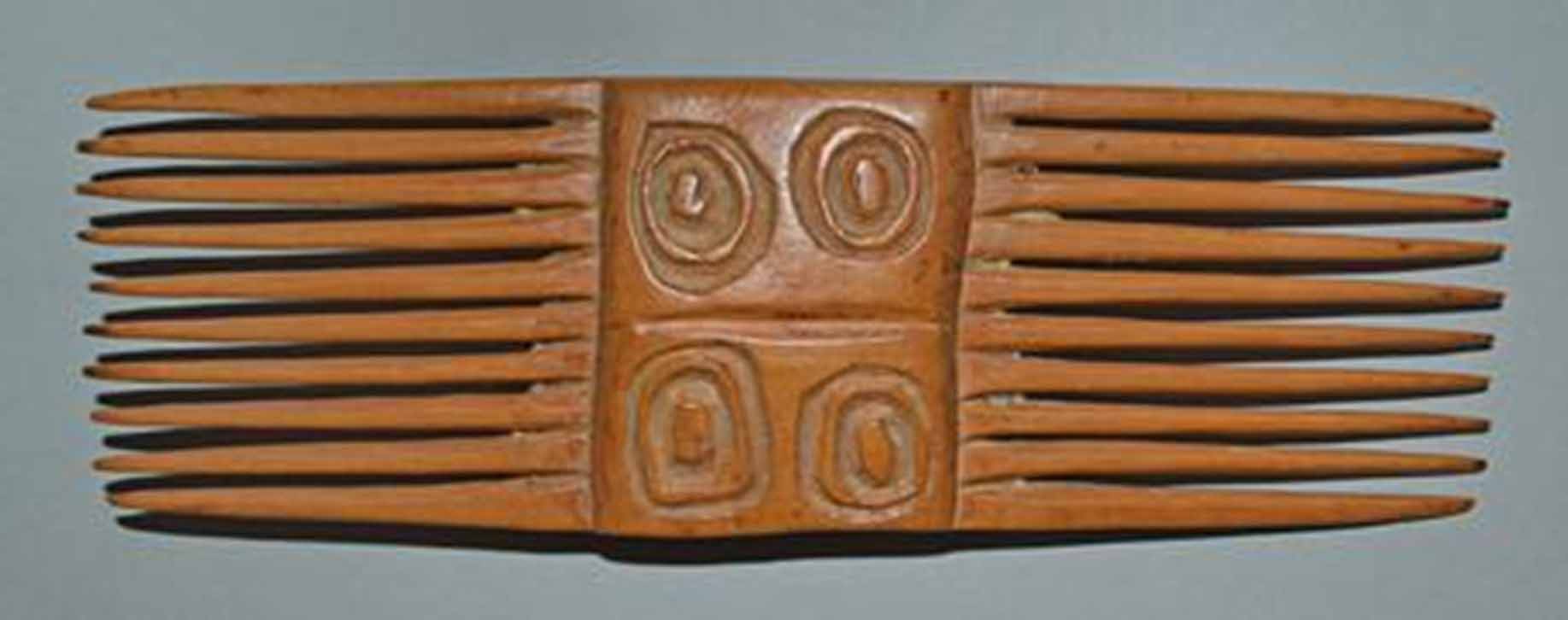
West Coast Vancouver Island
The following observations were made among the Nuu-chan-nulth. King, on the Cook expedition, describes ornamental combs in Nootka Sound in 1778:
“They have combs, the wideness of whose teeth make them one would suppose useless, but are Carv’d neatly & worn in their heads” (King 1784).
In 1792, near the same location, the botanist Jose Mozino observed: “Hair styles vary somewhat; the common one consists of wearing the hair loose, cut evenly at the ends. Others wear it in the form of a simple braid, tied with band to which are attached some cedar leaves in the form of a top knot” (Mozino 1970).
In 1817, Roquefeuil, while visiting Nootka Sound observed a makeup kit with a comb inside: “After dinner, Eachtel shewed a small round box, which served him as a dressing case. It contained a comb, some necklaces and ear rings, a mirror, some down to serve as powder, and several little bags, with black, white, and a red dust, resembling black lead. Few of the natives go from home without these articles” (Mozino 1970).
Explorer Robert Brown observed among the Muchalat in Tlupana arm in 1869, that one man was wearing his “long matted locks …fastened up behind in a knot with a wisp of cedar bark” (Brown 1869).
There is a unique example of a photograph, RBCM PN4712, showing an Ehattesaht girl from Queen Cove (fig. 6). Her comb was pinned to her clock and used to scratch her head without touching herself as is required in the ceremony.
Ahousaht band member George Louie told me on April 14, 1983, that this was a ceremonial dress used during a coming-of-age ceremony. In this photo she is wearing two hair braids covered with an ornament composed of a wool band and strings of European glass beads topped with thimbles that jingle during movement. The elaboration of the hair is dependent on the rank and wealth of the family. This dual braid style of ornament indicates the girl was a younger daughter. An eldest daughter wore a single ornament (Drucker 1951).
“Only one type of comb is found among the Clayoquot. It is seldom used by the men, and, while used only perhaps every third day by the women to disentangle their locks, it is regularly worn in the hair to keep it in place. The comb has two names, depending upon the purpose for which it is used. When used to brush the hair, it is called suchk aghs; when used to rid the head of vermin, it is known as the hech yek. The comb is made of yew-wood, two to three inches long and about the same in width. The teeth, an inch and a half long, and one-eighth inch thick, are spaced rather closely together. Grip and teeth are made of a single piece of wood.” (Koppert 1930).
Kwakwak’wakwa Speakers
Kwakiutl combs were of yew-wood, square, with 12-20 teeth at one end. Boas illustrates some of these. Those shown include one sided examples, with teeth that are both longer and shorter than the body (Boas 1909).
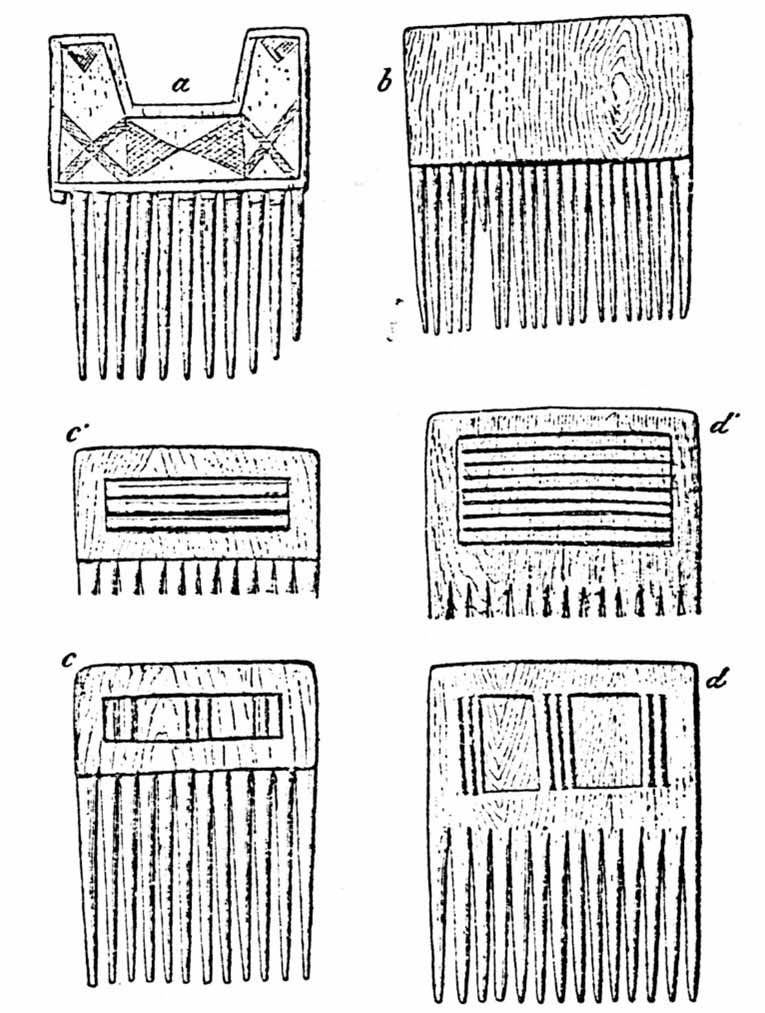
Northern and Central coast
There are numerous combs collected on the Northern Northwest Coast from the late 1700s to the early 20th century. Many of these appeared to have been more elaboratively carved due to the use of finer steel tools. Some were made as models by Indigenous people to sell. The date of manufacture of many of these combs in museum collections are biased toward being earlier than there is evidence for and some are models of earlier forms made by Indigenous artists. The Tlingit artist, Charlie Tagcook, carved the comb shown in figure 13, after a picture in a publication of Swanton. According to Tagcook “doctors used such combs ceremonially in the treatment of patients” (Gunther 1966). It is from the Portland Art Museum (48.3.359); (L 12 ¼ “ x W. 3 4/8; teeth L 1 5/8”), where it was obtained Nov. 19, 1936 and given a date of c.1930. The carving is of a hawk with eyes designs on front and back.
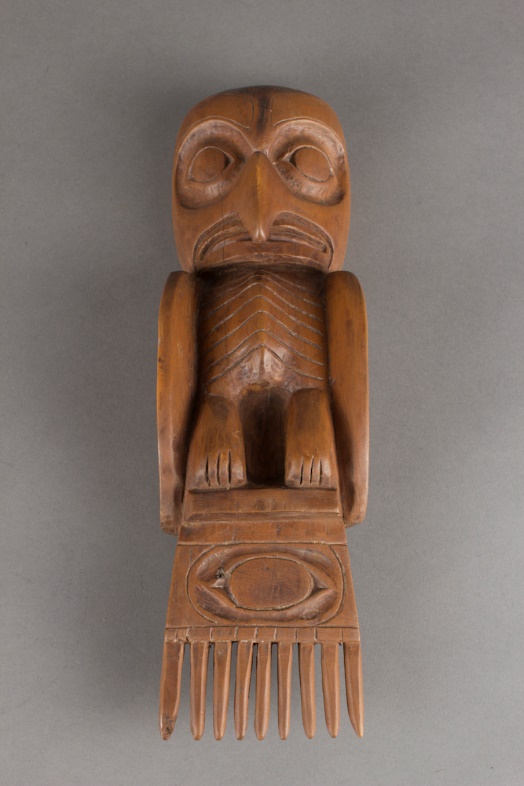
A Northern coast antler comb (Figure 14) from the Peabody Museum of Archaeology and Ethnology, Harvard University (PMH 67-10-10/266) (12.7×3.1.8cm), was collected in 1794, by Captain James Magee (Mallory 2000). On ships, such as those of Captain Kendrick (Columbia Rediviva) and Captain Gray (Lady Washington), trade goods included combs (Mallory 1998 A). Further research is needed to find out what these trade combs looked like.

James Deans noted that among the Haida: “Medicine men and women called Skah gillda or long-haired ones. Both sexes wore their long and tied up in a crown knot”. (1899:11).
The Sainsbury Museum has a bone or antler comb collected at Cross Sound, southern Alaska, in July 1794, during Captain George Vancouver’s voyage on HMS Discovery. The provenance of the comb makes it one of the earliest documented pieces to have been collected among the Tlingit people (Figure 15). It shows the grooves on the teeth that are part of the earlier manufacturing process.
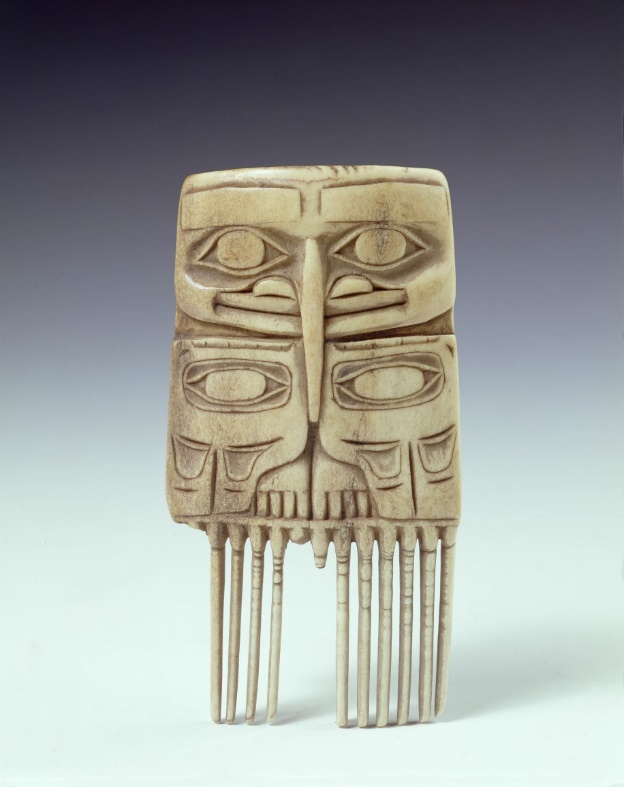
George Emmons collected information on Tlingit hair styles in the 1880-90 period:
“both sexes worn hair long …that of the men straggling or tied up on top of the head and matted with grease, red ochre, and adhering birds’ down. The powdering of the hair with eagle down was done on all dance or ceremonial occasions”. The women wore the hair in one plait, or confined at the neck and hanging down the back …Young women of the higher class wore ornaments attached to the plait when the hair was confined at the neck”. The hair of the shaman was never cut. “When practicing he wore it hanging down, but at other times it was tied in a knot on top of the head and fastened with a comb, bone pin or string” (Emmons 1991).
Tlingit women “carefully combed, washed, and kept free of grease and paint”. In 1786, the Tlingit women “wore the hair either clubbed behind or tied up in a bunch on the crown of the head; men wear theirs either loose or tied at the crown”. (Portlock 1789).
Figure 16, shows just a few of the many examples of Northern Coast Combs. These examples are from the American museum of Natural History.
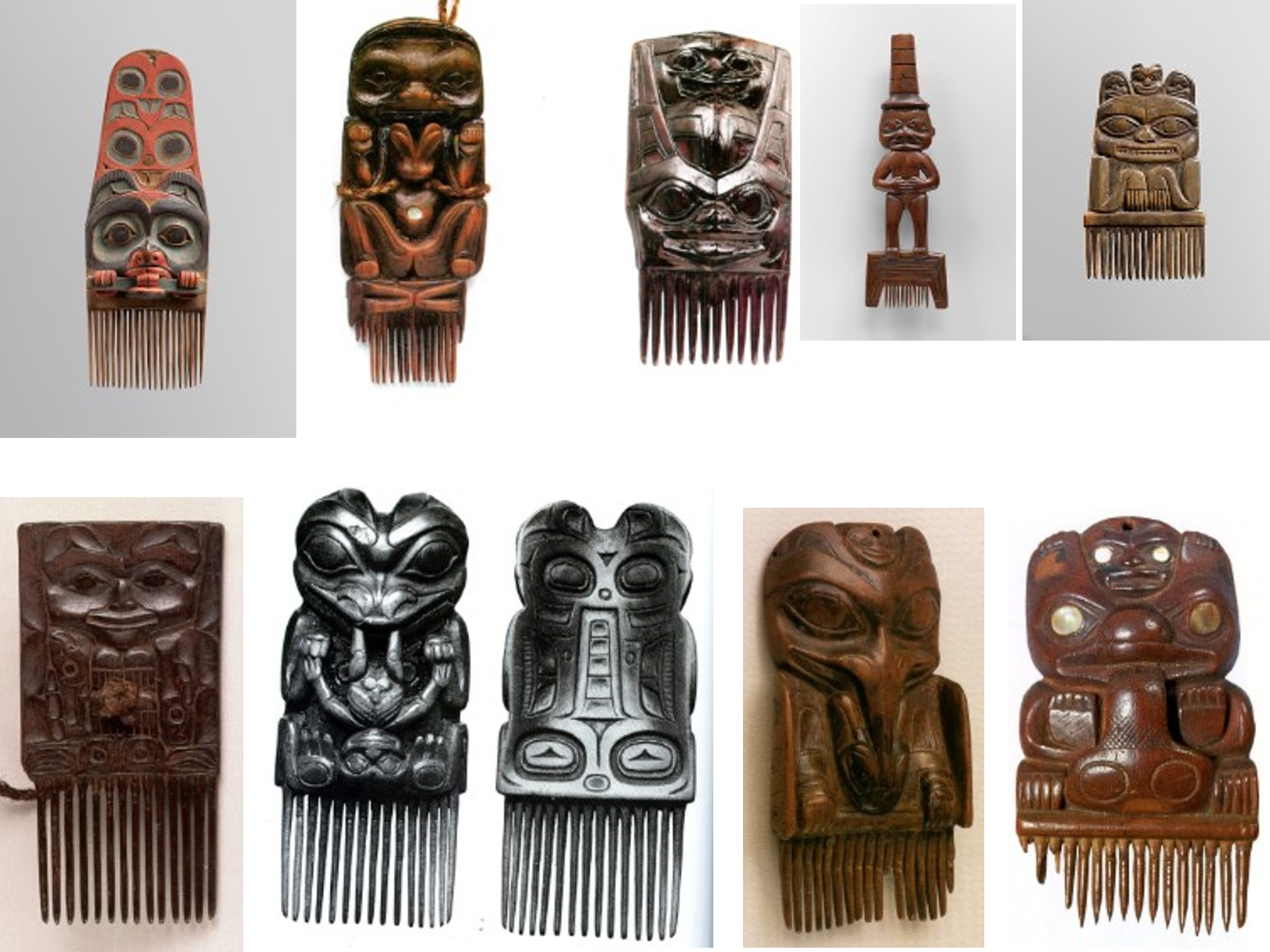
Upper row left to right:
1st. Tlingit. Ca. 1860. 24.8 x 8.9 x 3.8cm. Accession Number: L.2018.35.47
2nd. from right: Tlingit (Angoon Alaska) wood comb with bear design. United States National Museum NMAI/9/7966. Angoon, Purchased from Emmons in 1920. Height: 5 ¾”. Seventeen teeth. Abalone inlay in stomach of figure.
3rd from left: Tlingit, 1850-80. Accession Number: L.2018.35. (29.2 × 10.2 × 2.5 cm).
4th from left: Tlingit. ca. 1840. Mountain sheep horn with 18 teeth. Accession Number: L.2018.35.35. Accession Number: L.2018.35.35
Bottom Row
1st from left: Chilcat Tlingit. Bear with salmon and an owl below and on the otherside a bear with a raven. Collected by Emmons in 1882-87. 5” high. Connected with bundle of human hair. No. 302. 19/448.
2nd from right both sides shown. NMAI18/5784. Tlingit. A bear eating a human. Height: 5 3/4”. Twelve teeth. Purchased from Emmons in 1933.
3rd from right: A Tlingit (Sanya Tribe near Tongass) wooden comb with 17 teeth. AMNH No 303. Height 5 ½”. A sandhill crane with a frog in its mouth. A human spirit appears between the ears of the crane. Collected by Emmons 1884-7.
4th from right: AMNH 16.1/795. No. 304. Wood. Figure of bear. A spirit figure above bear has its hands on the bears ears and its feet below the bear’s head. Height 5 1/8”. Purchased from Emmons in 1926.
Figure 17, shows examples of combs collected on the northern coast of British Columbia by Johan Jacobson in 1881-83. They are in the Staatliche Museum of Berlin.
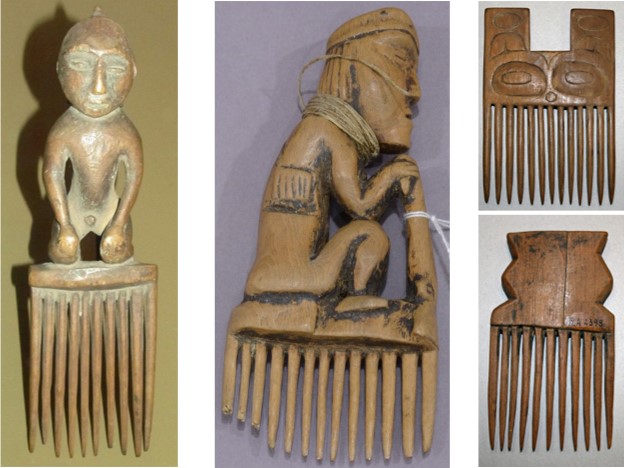
Interior British Columbia
“During a girls’ puberty ceremony, she was provided with a wooden comb, a bark wiper, a scratcher, a drinking tube and whistle of bone, all of which she wore attached to a thong wore around her neck. Some girls wore the comb stuck in the knot of her hair, and the scratcher in the other. Some scratchers were two-pronged and made of wood” (Teit 1909)
The hair bundle knots of men were often on top of the head and hanging over the brow . In the Thompson River area during the puberty isolation: “For combing, the girl used a four or five pronged comb, that her periods of menstruation might never be prolonged over that number of days” (Teit 1900). Teit noted that the combs of the Secwepemc (Shuswap) “were exactly like those of the Thompson tribe. They were made of wild gooseberry wood, but the wood of Philadelphus Lewisii Pursh (wa’xaselp) was preferred when it could be obtained. Sometimes this wood was procured from the Lillooet. The Fraser River bands occasionally made combs from single thin pieces of birch and juniper wood), like those in vogue among the Chilcotin and Carrier”. Figure 18, shows Teit’s examples. The 9.3cm long comb on the left has 14 teeth. Second from left is a 13.2cm comb with 8 teeth (two broken off) (Teit 1909).
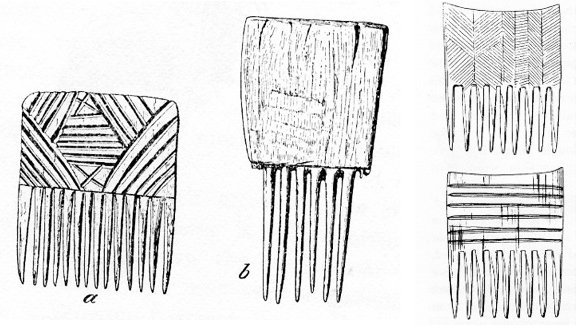
Among the Thompson: “The women combed the hair of their husbands. Combs were made of wood split into thin strips and glued together” Teit indicates that the examples in three of his figures “represent the most common forms in use” (Teit 1900). These combs are similar to the southern coast examples in the RBCM (RBCM 17485 and RBCM 7068) with multiple separate teeth forming the comb.
James Teit and his relatives in the Spencer’s Bridge band often make replicas of clothing and other items of types no longer being used, which were then sold to several museums. The examples in figure 19, may be some of the re-created artifacts rather than ones that were actually used as cultural items.
Teit’s view on the subject is clearly expressed in a 1915, letter he sent to Ethnologist Edward Sapir:
“I tried to sell my collection to Mr. Heye in New York but he is willing only to buy those things in it which have actually been in use no matter how good the others are … I do not mind sending them for inspection as much but think that his buying only things which have seen actual service is not on the whole the best method of showing the old culture of an area. Specimens in use now a days are generally more or less modified and not true types of the old culture although of course they have their value.
It would be impossible to get a clear and full idea of the old material culture of the area …by purchasing specimens only of things now in use. The only way to do is to obtain from the Indians who have the knowledge specimens made by them which are true copies of the things formerly in use. Most of my collection consists of this kind of material, the specimens having been used only to the extent to show they were actually serviceable such as some kinds of tools and games & etc. and clothes worn a time or two at a dance of gathering or for the making of pictures and then sold to me”.
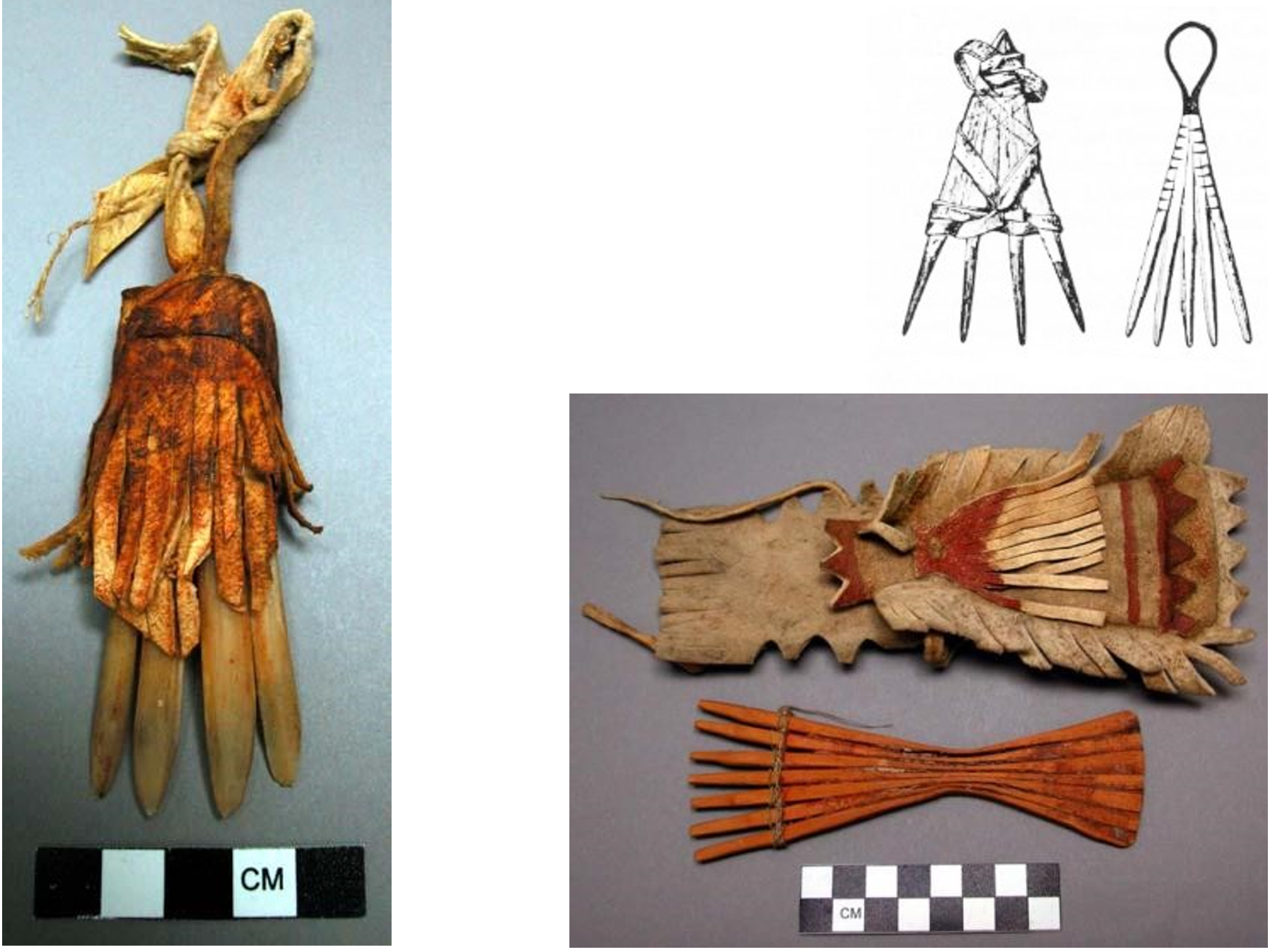
Right Bottom. Thompson. Carved wood comb in buckskin case. Peabody Museum No.15-36-10. Purchased 1915. Fan-shaped with thread lashing. 14.4 x 5 x 0.6 cm.
Left Bottom. Thompson. Peabody Museum. Collected 1915. James Teit. Pubescent’s comb consisting of four teeth of bone. Top part enclosed in buckskin; stained with red ochre (8.8 x 3.3 x 2 cm).
Morice (1893), shows a regular hair comb (Figure 20) and comments that it: “was immediately used by them immediately before it was handed to me. …An examination of the cut will reveal the extreme simplicity of the process of manufacture of this article. A set of small holes have first been drilled with a hole borer. After which the portions of the wood whose veins had thus been cut asunder have been extracted with the knife leaving out what becomes the tines or prongs of the comb”. He notes “The Carrier name of the comb is tsi-ltzu ‘the head is curried’ a verbal noun”.
Morice also illustrates a special comb (Figure 21).
“The original comb of the Western Denes was remarkable for the length of its prongs rendered necessary by their peculiar way of wearing the hair prior to their first encounter with European civilization. In all probability, it was made in about the same style as the above Carrier comb (here Figure 21) which is not a toilet article, but served the purpose of ritual observances. To secure success in his trapping or snaring operations, the Carrier had, besides lying down by the fireside, dreaming, etc,, to make use of this three-pronged comb, which consists in the juxtaposition of as many wooden pins bound together with sinew lines.”
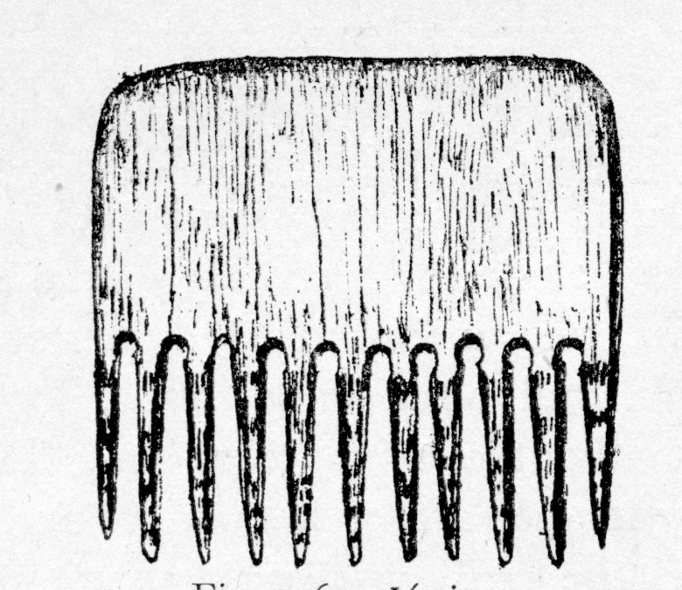

RBCM Ethnology Comb Descriptions
Southern Coast Salish Region
RBCM 17486 – Coast Salish. L:185. Width across the distal end is 98mm and about 19mm at the proximal end. A comb consisting of thirteen separate wooden teeth that are tied across the proximal end with woven woolen cord to hold it together. The teeth extend 63mm beyond the woven area. The sprayed-out teeth vary in spacing from 3-5mm, being wider at the distal end.
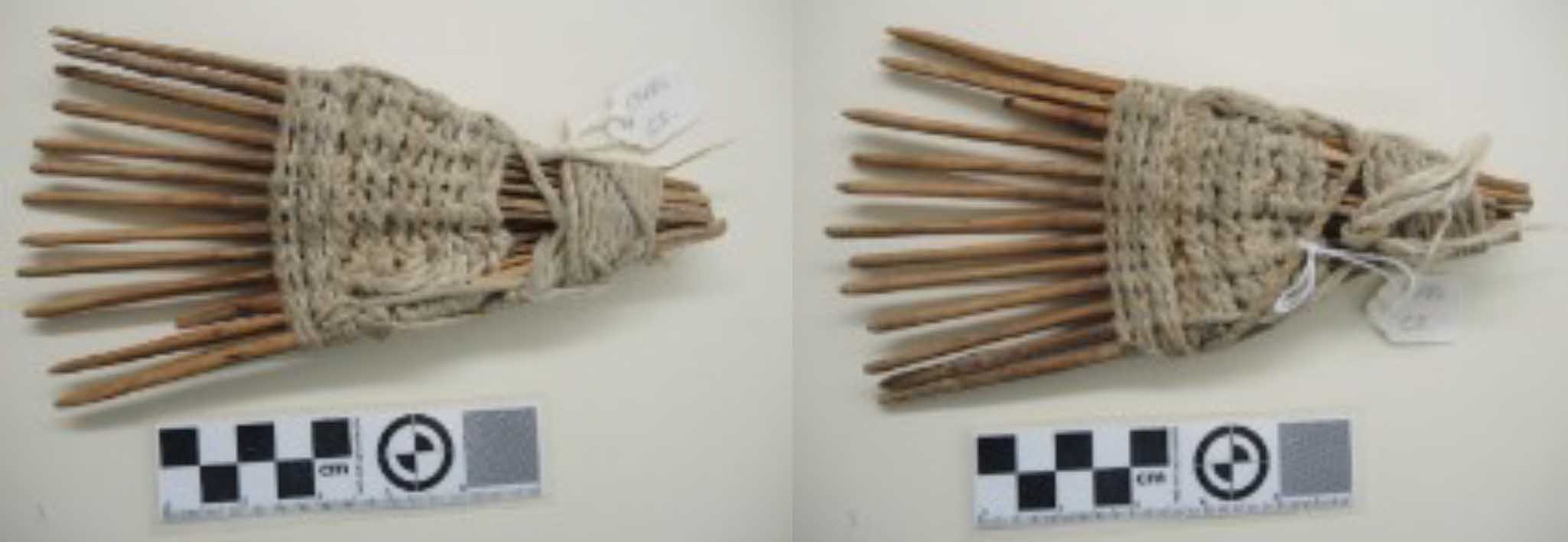
RBCM 7068 – Thetis Island. Cowichan. A wooden comb that once consisted of six separate wooden teeth that were tied across the proximal end with woven wild cherry bark. The lengths of the six wooden teeth as shown in figure —- from top to bottom are: 120mm; 163mm; 175mm; 177mm; 173mm; 108mm. It has fallen apart. This is an archaeological example taken from a cave on Thetis Island and donated in 1951.
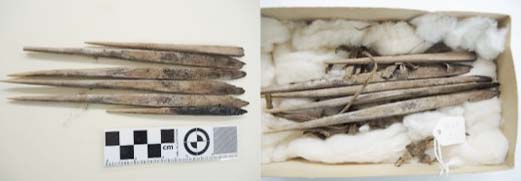
RBCM 13015. Salish. Lower Fraser River Region. L:104mm. W: 44mm. Double sided wooden comb. The rectangular 44mm by 39mm high shaft has eleven 31mm teeth on each side. Eleven of which are broken. The teeth are very thin at 3mm and spaced 3mm apart. There is a carved perforated oval hole in centre of the shaft, 29mm wide by 7mm high. Listed as: “Unspecified Salish”. It was included in a large archaeological collection (Acc. No. 67-4) from Fraser Valley. As the extent of his collection area is not certain it can only be assumed that this comb is from the Lower Fraser River region. The condition of the comb, donated in 1968, suggests that it is an archaeological example.
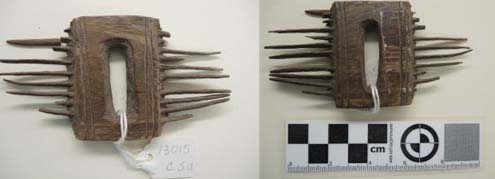
Nuu-chan-nulth
RBCM 14206. Nuu-chan-nulth. L: 97mm. W: 38mm. Made of antler. The shaft is rectangular, 41mm by 60mm high, with a constructed or inset neck area below a head at the proximal end (Figure 25). An incised face has two drilled eye holes and incised designs from the brow to nose area. It has nine 37mm long teeth on one side spaced 2-3mm apart. Catalogued: “Nootka”. Donated from the A.E. Caldwell collection on Feb. 6, 1974. The majority of Caldwell’s collection is from Ahousaht where he lived from 1934-39. He also lived at Kitimat in 1939-40. In 1960, he returned to Alberni. This appears to be an archaeological artifact from a shell midden. It probably had shell inlay eyes that are missing.

RBCM 19400. Nuu-chan-nulth. Location unknown. L:121mm. W:70mm. Shaft Height: 51mm. Rounded proximal end of shaft with cut out area inside, leaving thin band around top with the exception of two square areas on each side of base of cut out area. Cut out raised bar across above teeth. Ten teeth on one side, 70mm high. The teeth are cut with the grain starting at the top of teeth (Figure 26).

Kwakwaka’wakw
RBCM 6531 – Kwakwaka’wakw. L: 100mm. Width: 80mm. Shaft height 56mm and width 80mm (Figure 27). Shaft has a cut out area forming two raised extensions on both sides at proximal end of comb, with a curvature on the inside of the extensions. A decorative line is cut just above the teeth. There are thirteen 44mm teeth on one side. Spacing between teeth is 2-5mm. Original catalogue has: “Kwakiutl”. Locality “Unknown”. Donated in 1948, by “Canon Beanlands” of Victoria.

RBCM 9995 – Kwakwaka’wakw. Nimpkish. L. 68mm. W: 70mm. Rectangular shaft longest side to side 70mm by 30mm (Figure 28). Four wave patterns carved across shaft. Eleven 38mm teeth on one side, with spacing of teeth 3-4mm. Catalogue: “Kwakiutl – Alert Bay- Comb – yew-11 prongs – reddish paint smeared on”. Collected by Charles Newcombe in 1912, at the same time as no.1993. Acquired with Newcombe collection in 1961.
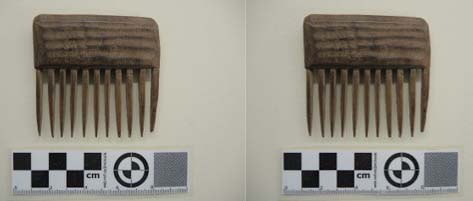
RBCM 1993 – Kwakwaka’wakw. L: 90mm. W: 61mm (Figure 29). Rectangular shaft longest side to side. W: 61mm. H: 41mm. Eight teeth on one side with height of 48mm. Teeth spacing 2-3mm. Catalogue listed as: “Kwakiutl”. Collected by Charles Newcombe at Alert Bay in 1912, at same time as RBCM 9995.
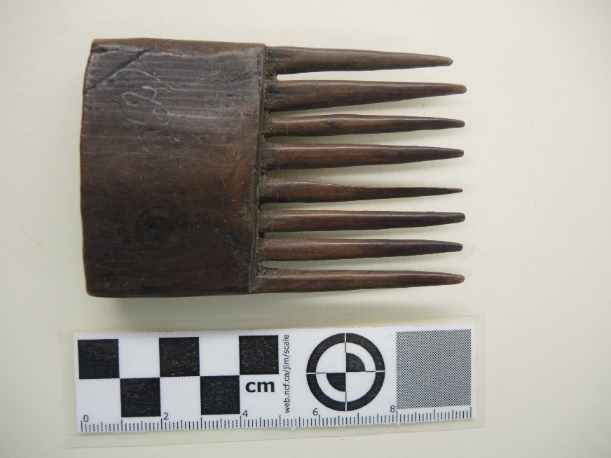
RBCM 10519. Kwakwaka’wakw. L: 103mm. W: 38mm. Rectangular shaft higher from top to bottom (Figure 30), W: 38mm. H: 55mm. Six, 48mm teeth on one side with 3mm spacing. Catalogue: “Kwakiutl – Cob Yew – narrow type 6 teeth”. Probably collected in early 1900s. Acquired with Newcombe collection in 1961. Close-up shows wide spacing of teeth.
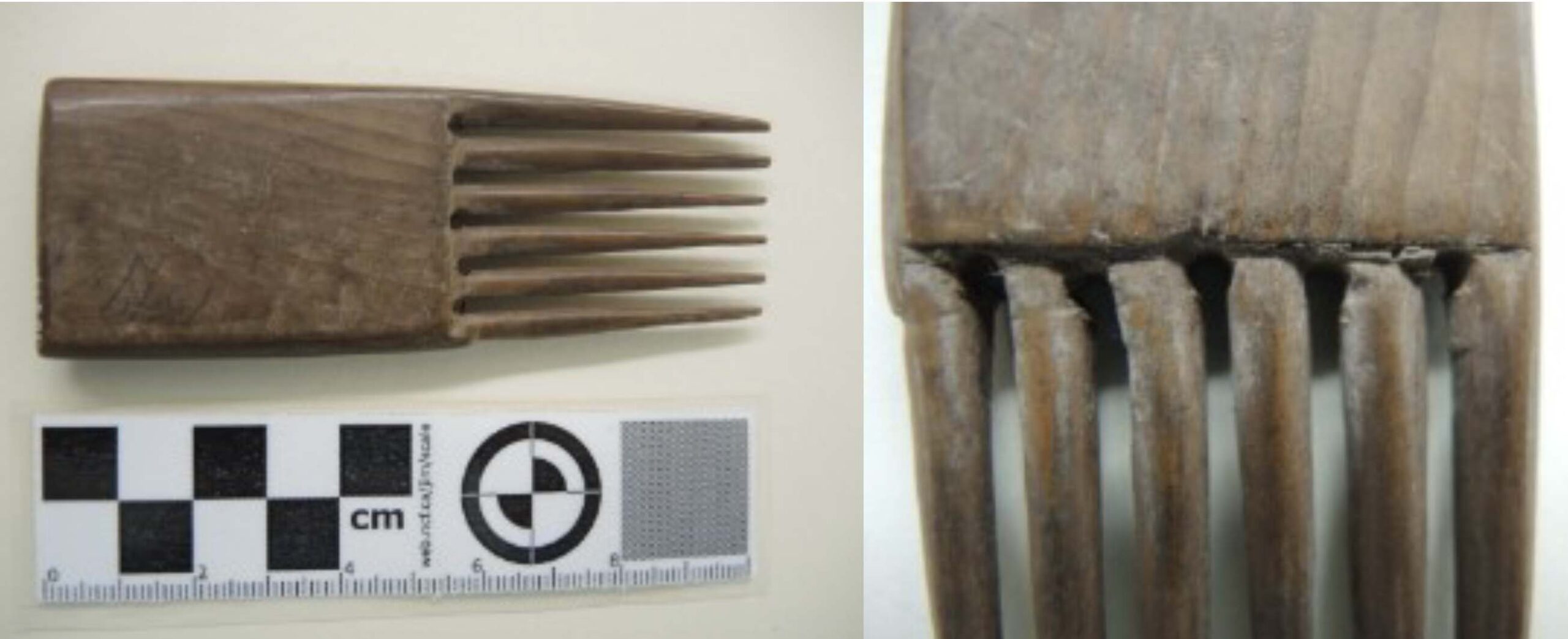
Central and Northern Coast
RBCM 179 – Bella Bella. Length: 127mm. Width: 69mm. Rectangular shaft with greatest shaft length from side to side (Figure 31). Shaft Height 69mm. The eleven, 75mm high teeth have 2-3mm spacing between them. Collected by “spt. Roycroft” (Police Inspector). Published in RBCM 1898 preliminary catalogue.
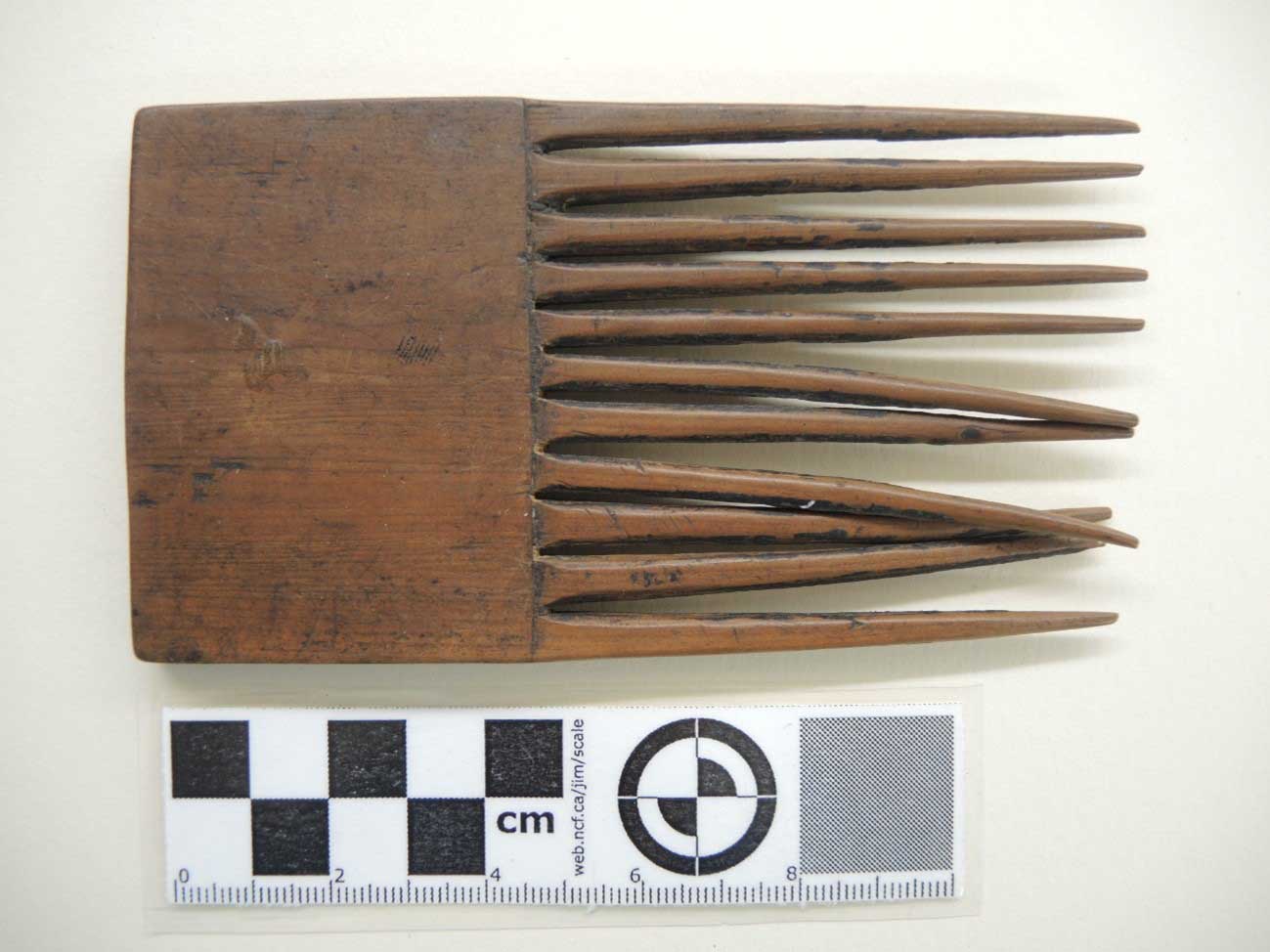
RBCM. Coast Tsimshian. Gitzaklath. Collected in 1891, at Port Simpson by Walter B. Anderson (Figure 32). Walter was familiar with ethnographic artifacts and the son of Alexander C. Anderson of the Hudson’s Bay Company. The original catalogue describes the “head of hawk carved on handle”. Rectangular shaft with greatest shaft length from top to bottom. Rounded proximal end. Length: 115mm. Width: 75mm. It has 14 teeth on one side, 44mm high. Teeth spacing 2-3mm. Published in Plate XVI in the Provincial Museum collection guide for 1909. Figure 32, show both sides and side view of the comb as well as the organic material visible between the teeth.

Paint scratcher Combs
RBCM 2763. Interior Salish. Paint scratcher comb (Figure 33). A distal portion of deer jaw bone wrapped in thick leather with six incisor teeth exposed at distal end. Length: 111mm. Distal Width: 62mm. Proximal width 18mm. Thick: 29mm. It is widest across the six touching teeth that have no space in between them. The original paper tag is an old number 190 in black ink crossed out and 190 added. Also in ink is the word “Nilak”, which may be the name it was given? In pencil on same tag is: “Paint scraper”. A blue paint circle on the leather is located in the middle of the top of the distal end and a blue line with another line arching over it are located across the distal end above the row of teeth. Extending out the proximal end is a 107mm double leather strip with small loop at end.
Figure 33. Two sides of Paint scratcher Comb. RBCM 2763.
RBCM 2764. Interior Salish. Paint scratcher. L: 111mm. Width across distal end 33mm and 31mm across distal teeth. Proximal end 21mm (Figure 34). Elongate item wrapped in thin raw hide with four carved teeth made of sheep or goat horn. The teeth like structures are protruding at the distal end 14-17mm. The teeth are 4mm thick and spacing between them is 5-6mm. A loop of skin extends out from proximal end. Original catalogue: “Salish Thompson River – girls -hair comb. Paint scratcher?”. Collected by James A. Teit in 1911-12. Although this would serve as an instrument for making painted lines it would not function as a comb for coming hair. This is likely one of the models that Teit had members of his reserve create to show how they used to be, rather than one that was actually used as a paint scratcher.
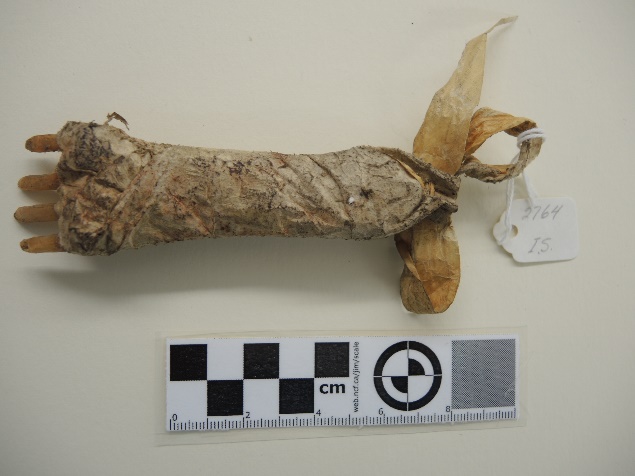
Overview of Archaeological Collection Combs
Victoria Region Archaeology combs
Antler comb, DcRu-12:3700, from the Maplebank site, in Esquimalt Harbour on the Songhees Nation Reserve. L:104mm. W:40mm. Five 35mm long teeth with 3mm spacing. Excavation Unit 2, Zone B. (Figure 35). I obtained a charcoal sample for radio-carbon dating this comb in 1975, from just below the comb. Dating to c. 640 A.D. (uncorrected date of 1310+/-70). Wolf or dog in transition or human in mask. Author pointing to location of comb find in figure 36.

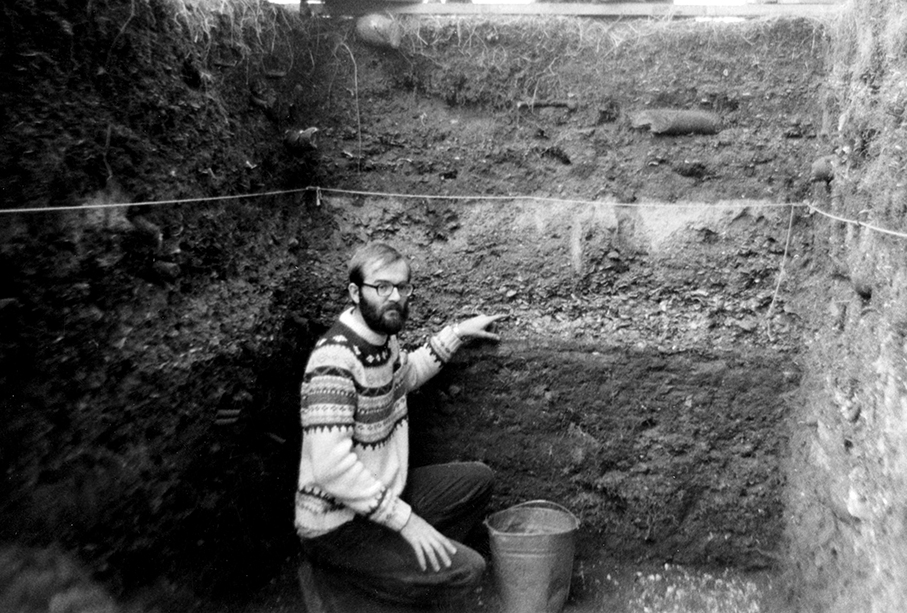
Figure 37, shows the waterlogged comb from DcRu-132, in the Millstream delta area of Esquimalt Harbour. L. 83mm. W. 48mm. It was found in mud at low tide by a private citizen. Professionally identified as being made of the Pacific dogwood (Cornus species), by Terry Holmes of the Pacific Forestry Centre of National Resources Canada.
This location is in the traditional territory of the Lekwungen (Songhees and Xwsepsum Nations). The comb was carefully scooped up with the soil matrix below it and kept wet. Fast drying out of waterlogged artifacts can cause them to shrink and fall apart. Given the poor saturated state of this comb, it could not be conserved in its state as seen here.

DcRu-760:218. Antler comb. Five broken teeth. Recovered under excavation permit # 9926, by Millenium research (Figure 38). It weighs 14.5 grams. Measurements include: Total original length c. 100mm, current length 79mm. 54mm from top to line at base of body where it is 35mm wide and 6.5mm thick. It is 27mm across the indented area of the body. The carved oval on one side is 24x15mm. The space between the teeth 3.5mm. The manufacturing grooves are present on remaining parts of two teeth.
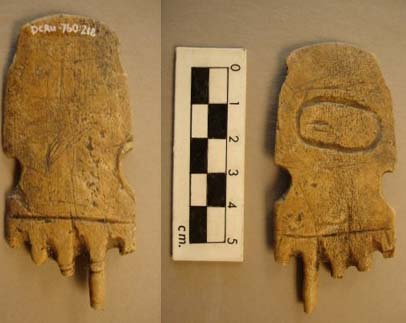
DeRu-1:1654. [old #1944-2). Blue Heron Lagoon site, Sidney. Lower portion of broken comb with portion of shaft and two complete and three broken off teeth (Figure 39). The teeth show the manufacturing rings engraved around the teeth. The back side shows the rougher inner cell structure of the antler. In a letter of Francis Barrow to Harlin Smith of December 17, 1935, he explains how he found the comb “Walking along the beach behind where the old hotel was”. Length 74mm; Width 36mm; thickness 8.5mm.

DcRu-2:160 [old #72-232]. Small double sided flea comb of turtle shell (Figure 40). A section along one side is missing. At least 45 teeth on both sides of body. Length 45mm; Width incomplete 32mm; Thickness 2mm. Mid-section between teeth is 19.5mm in length. Weight 2.5 grams. An extension occurs along both sides extending from 4mm to 2mm. The teeth are 13mm long with spaces of 1mm. This is an historic comb that was possibly purchased at the Hudson’s Bay trading store in the 19th century. There are what appear to be illegible initials etched on one side. It was found on an ancient shell midden, but it is uncertain if it was used by an indigenous person, as many non-Indigenous activities were undertaken at this location. In the 19th century.

Private collection. This antler comb is from the Esquimalt Lagoon area (Figure 41). The specific archaeological site is not known. It has 11 teeth on each side and circle and dot motifs on both sides of the shaft. The teeth spacing is similar on both sides.

Lower Fraser River Region Combs
DgRs-30. Fragmented comb. Teeth and body. No Image.
“Eight small, pointed pieces of wood, each broken at one end, and six “shaft” fragments broken at both ends, were found together with the points aligned, suggesting they might be the broken teeth of a comb. The objects were carved from an indeterminate hardwood. Each is straight and round in cross-section, tapering evenly toward the point. Three of the “shaft” fragments fit onto three respective pointed fragments and these pairs have been treated as one in obtaining the dimensions summarized in Table 7. Width and thickness were measured at the broken proximal ends. The lone “shaft” fragments measure 4.0 x 2.8 x (25.1) mm, 3.4 x 2.2 x (21.2) mm, and 3.1 x 2.4 x (8.4) mm respectively” Teeth dimensions of 41, range in length 8.4 – 38.8mm; in width 2.7 – 4.0 mm; thickness 1.6-1.9mm. . (Bernick 1989).
DhRs-1:9478. Vancouver region. Upper body portion of comb (Figure 42). Width 46.5mm by 3.5mm thick. Found at the Eburne site in 1931. Transferred from the Saskatchewin Museum (old #5345).
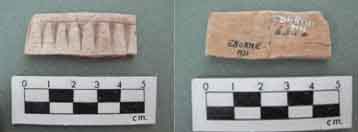
Borden Illustrates two combs from the Stselax Phase late period of the Stselax winter village DhRt-2 at the mouth of the Fraser River (Figure 43).
One is 7.49cm long with 8 long teeth of which 6 are still intact. It once had an open loop above its rectangular shaft which is broken. Geometric designs are on the shaft. The other comb is small and thinner with the shaft having a human-like face and indented neck area. is 7.35cm long with 7 teeth of which three are broken.
Borden dates the site to around the 1250 to 1290 A.D. time period. Borden states that “combs are rare in archaeological deposits in the Fraser Delta region, a major reason probably being that, as in recent times, combs were usually made of wood and hence are not preserved”. “One plain comb of wapiti antler was excavated at old Musqueam (DhRt-3), dating too about the third or fourth century B.C. of the Marpole phase” (Borden 1983).
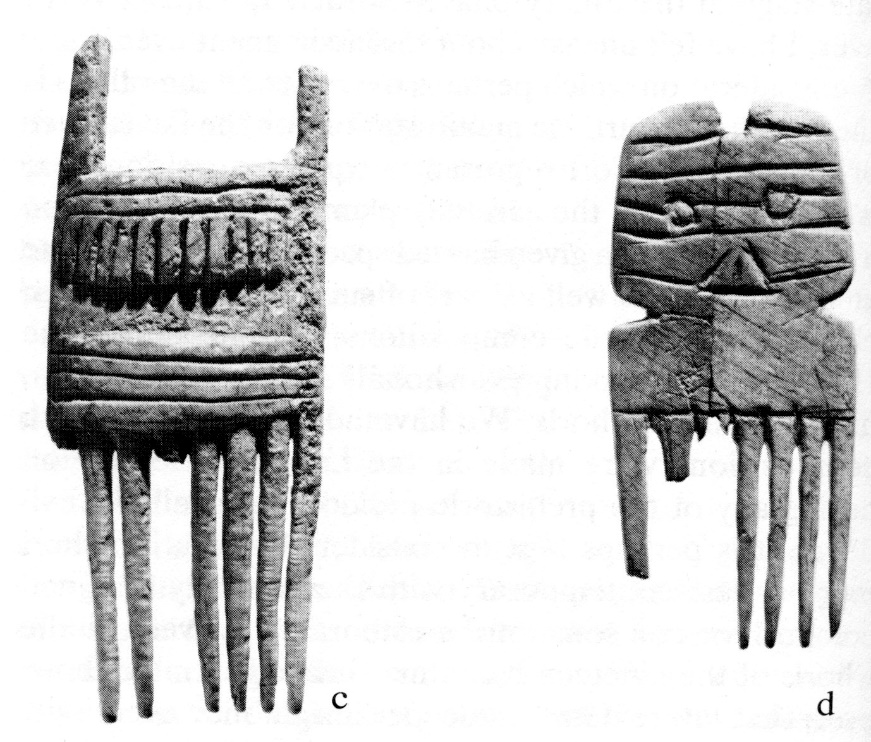
The Eburne site, DhRs-1:9478. This unfinished antler comb (Figure 44) provides a good example of how some combs were made. There are eight unfinished longitudinal grooves for creating teeth. This would have been made with a stone graving tool. It has an oblong shaft with a rounded proximal end. Five of the teeth are broken off. (1903).
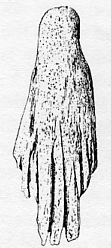
Nuu-chah-nulth Archaeology Combs
Barkley Sound. Antler comb from the Ts’ishaa village of Hiikwis (Figure 75). Archaeological site DfSi-16, from the middle terrace, dating to A.D. 1040 to 1240 (Calibrated 880-/+40bp. Beta 250331). It has a square shaft with a wolf-like animal carved on top and a series of six lines across the shaft (10.3×3.2 x 0.7cm). There are seven teeth with six broken off (McMillan and St. Claire 2005; McMillan 2019).

DfSi-16 Benson Island. A complete sea mammal bone comb with six teeth from Ts’ishaa. (10.3×3.2×0.7cm). From the Middle terrace of EA2. Dating to 64o – 470 cal. BP (McMillan and St. Clair 2005).

Toquaht village of T’ukw’aa. DfSj-23. Antler. The shaft has an upper cut out section that is missing (Figure 46). The lower shaft portion has a hole drilled after the comb broke. All seven teeth are present, rounded at the tips, and each tooth was sectioned out using a graving tool (Macmillan 2000; 2005; McMillan, Monks and St. Clair 2023).
Figure 46-left, is a broken antler comb from the Touqaht village of T’ukw’aa, DfSj-23. The shaft has a rectangular bottom portion with a constriction above with a rounded edge oval shape. On top of the latter is a smaller rectangle extending up from the top of the oval portion. There are three rows of holes with 7 on the upper row and six on each row below. The constricted area has another 16 holes and the upper portion another eight with a larger central hole just below the top for suspension of the comb. The other side has 18 partially drilled holes in the bottom section 21 in the mid section and 8 in the top section. There are eight broken off teeth (McMillan, Monks and St. Clair 2023).

A broken antler comb from the Touqaht village of Ch’uumat’a, DiSf-4 (Figure 47) is from the late period and dates to “about 1000 years ago. …The fragment is missing one side and all its teeth, so its classification as a comb is speculative. The remaining portion of this object is zoomorphic in form, with two roughly –incised eyes and a V-shaped mouth at the upper surface. A projection along one side, with a cut-out space separating it from the body, would once have had a counterpart on the other side. Parallel incised bonds of horizontal lines surmounted by short perpendicular strokes cover the surface of this object on both faces” (McMillan and St. Clair 1992; McMillan 2002).
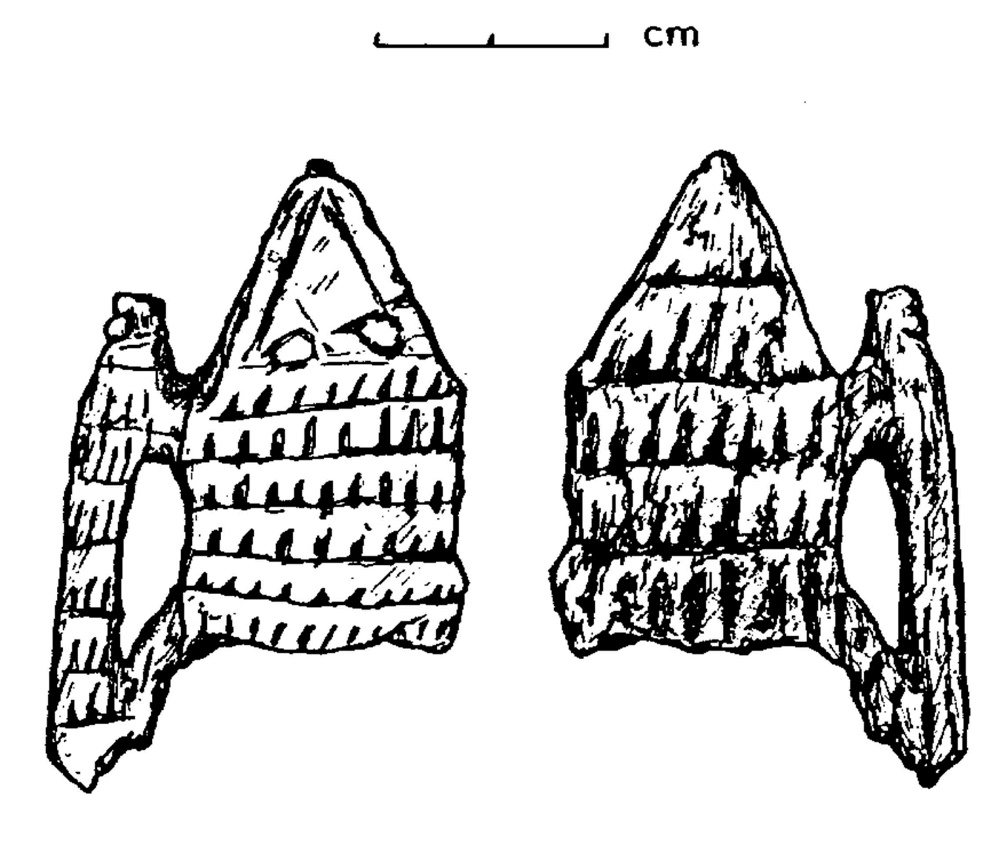
Hesquiaht Project Combs
There are five combs from the Hesquiaht project. Two of these, DiSo-1:940 and DiSo-9:556. are only small fragments. Not illustrated.
Figure 49, shows two sides of a complete wooden comb, DiSo-9:426. It has a rectangular shaft with seven teeth, Total L:87mm. Shaft: 36mm high by 31mm across. 10mm thick. Teeth row: 51mm high by 29m across. The teeth tips are rounded. There is an old break along one side of the shaft but wear patterns indicate it continued to be used.
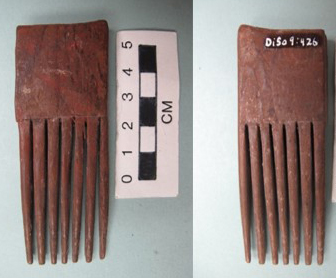
A Hesquiaht bone comb, DiSo-9:350, has a shaft with a carved design of the upper torso of a human figure at the centre with lightning-snake or wolf-like creatures standing on each side (Figure 50). One of the side figures is mostly broken off. (96mm x 44mm x 5mm). (Weight: 17.2 grams).
The animal figures are holding onto an elongate cut out section between them and the human figure. The teeth on the sides form the tail of the creature. The open spaces between figures are manufactured by drilling holes and graving the areas between them.
The detailed features are not carved on the back of the comb. The nine complete teeth are spaced 2-3mm apart.

A unique Hesquiaht bone comb, DiSo-11:1, has a squarish shaft with eight teeth (Figure 51). Length: 67mm. Shaft: 32mm across. 4mm thick. Weight 10.2 grams. There is a row of three drilled 3mm holes centered across from mid shaft below the proximal end. The teeth show the distinct grove marks from graving out each tooth and the notching marks around the teeth from their shaping with an abrasive, such as scouring rush, to round out the teeth. I considered that this might be a tattoo comb as there is more polish and use marks and rounded edges on one side and the holes in the shaft are reminiscent of holes on hafted Polynesian tattoo combs. However, the tips of the teeth are rounded and show no evidence of having once been sharp enough for a tattoo comb. Figure 51 shows both sides of comb and a close-up of the manufacturing grooves on the teeth.

Private Collections
This Ditidaht comb (Figure 52) is described from a photograph once in the collection of the late Edith Cross. The design theme is similar to that of the Hesquiaht comb, artifact DiSo-9:350.
It has a central human figure with two upright lightning snake-like creatures on each side. The human is holding them by the neck. There is a tear-like line extension coming down from their eyes. An oval suspension hole is in the forehead of the human figure. There is a raised belly button with a raised circle around it in a recessed circle. There are nine squarish shaped broken teeth that do not show the grooved cut marks seen on the more rounded teeth of other combs. The spaces between the teeth were made by the use of a graving tool starting at the bottom of the shaft. The bottom of the shaft has a series of cross-hatch designs extending across the front. It is made either of bone or antler.
The information obtained from tag in the photograph has: “Whale bone comb from Thompson. Nitinaht 1970. Passed down on his wife’s side”. Given the colour patterns on the broken off teeth ends, it is more likely that this was found by an Indigenous person eroding out an old village site than being a historic family heirloom.
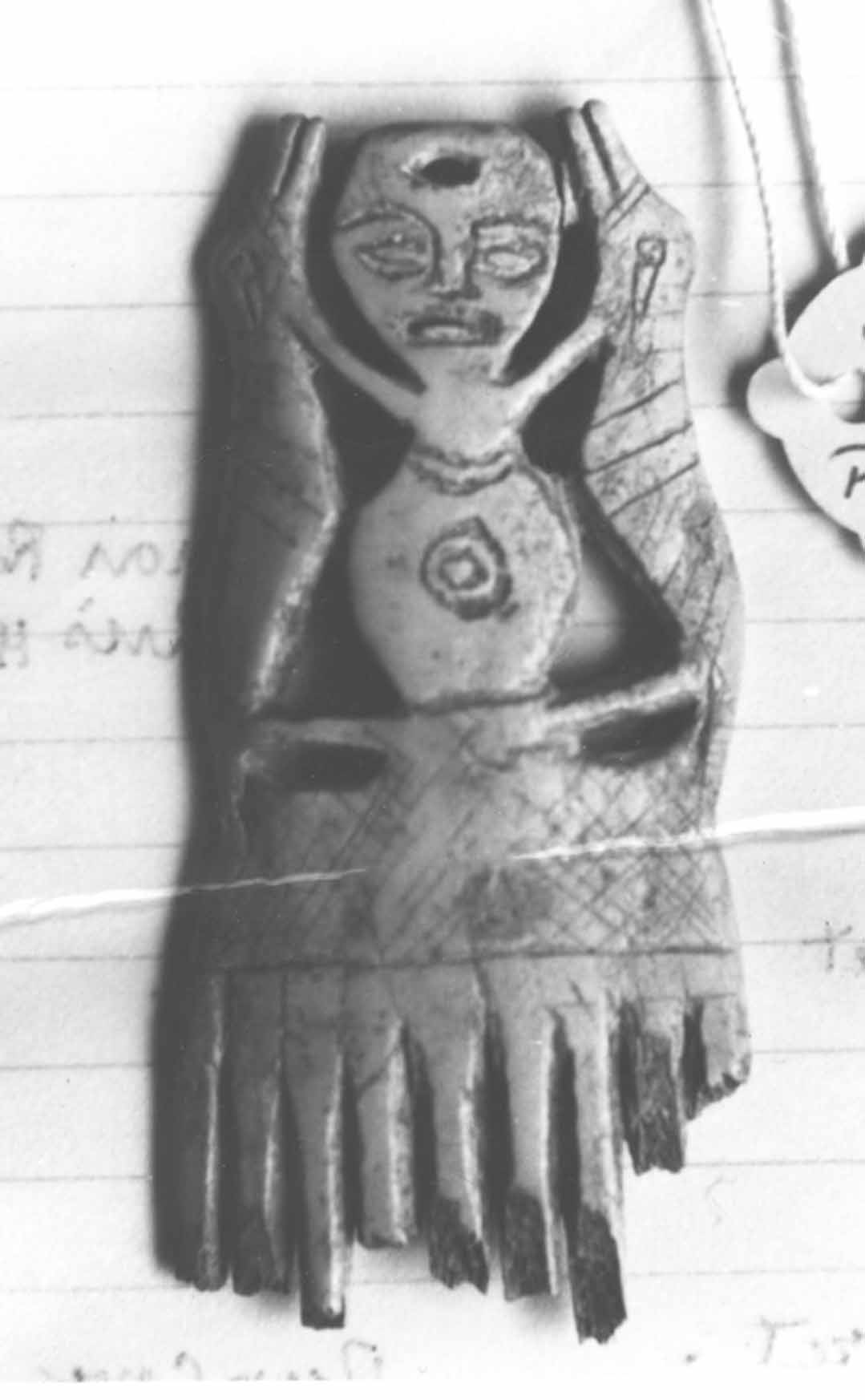
Private collection
This comb from the Kyuqout territory was found by a five-year-old boy in Kyoqout Channel south of Robin Point (Figure 53), on a beach at an extreme low tide (Figure 54). I examined this in 2009 and have given it the Borden unit designation, DlSt-Y. It has a cut-out pattern with a human upper torso with a head at the proximal end of the shaft. A central hole in the shaft has two arms extending down and up to the shoulders where the hands are resting. There are seven teeth with only one complete. There is no extra carving on the back.
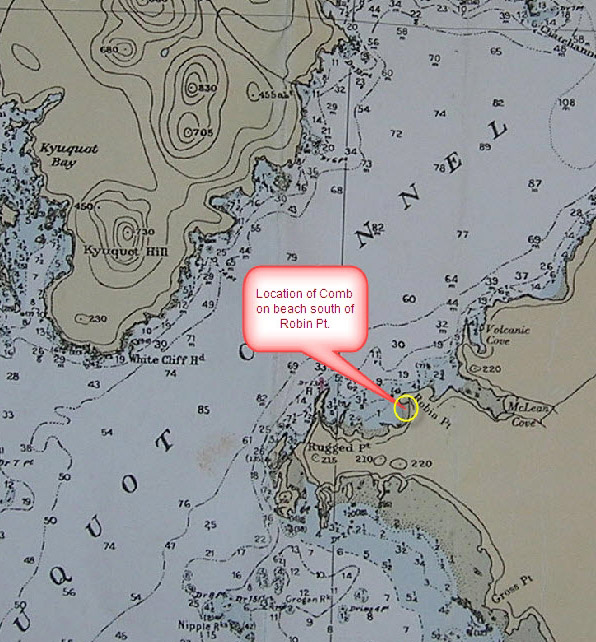
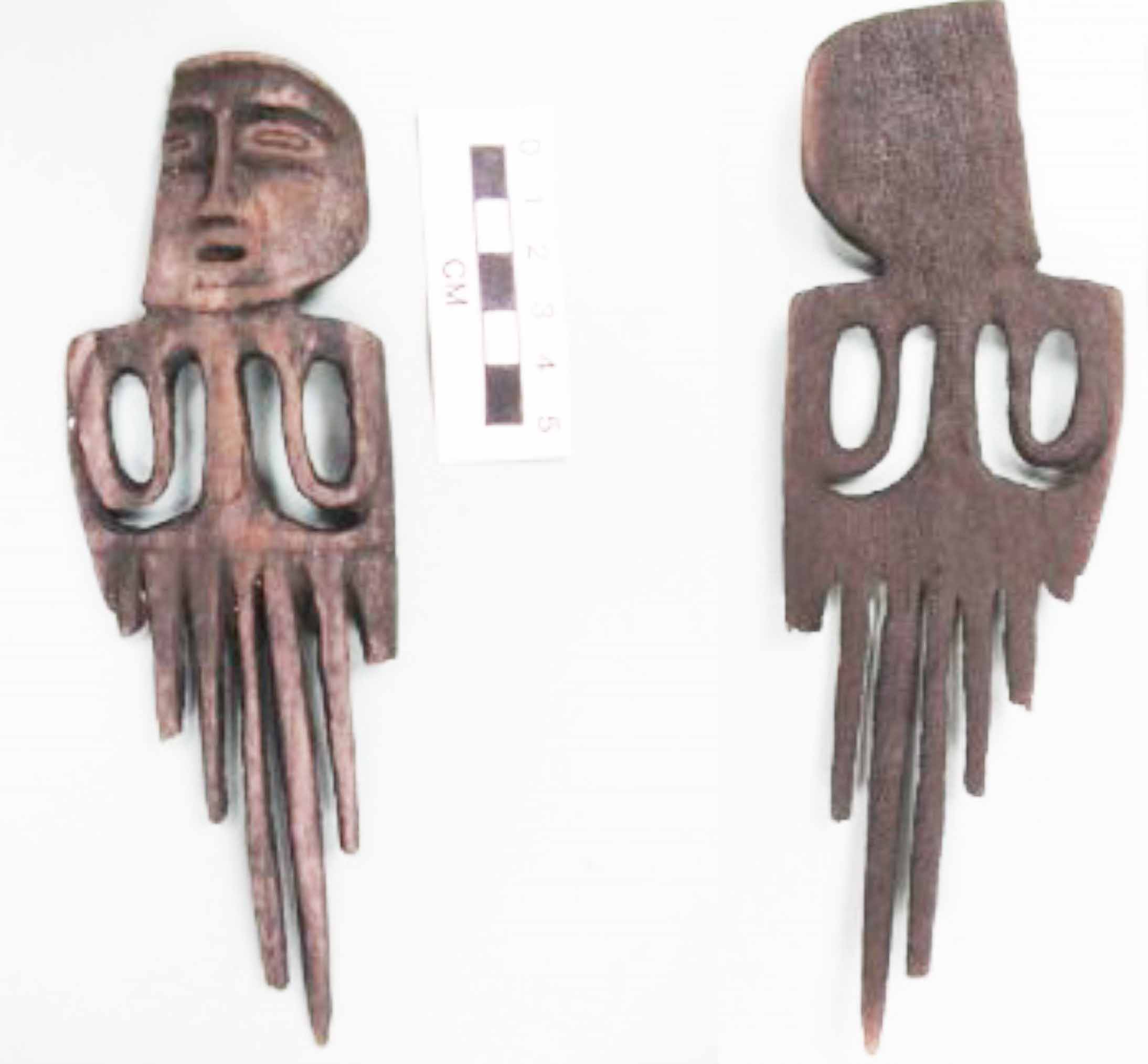
DhSx-Y. RBCM PN21471. Nanaimo region. Found below George Pearson Bridge. Human head figure at proximal end of comb body. In front are two engraved circle eyes and a carved-out mouth depression. The back of the head has three curved horizontal lines with three straight vertical lines extending downward from the bottom line – likely representing hair. An attachment hole is in the forehead. It has six teeth that are about ½ of the length of the comb (Figure 55).
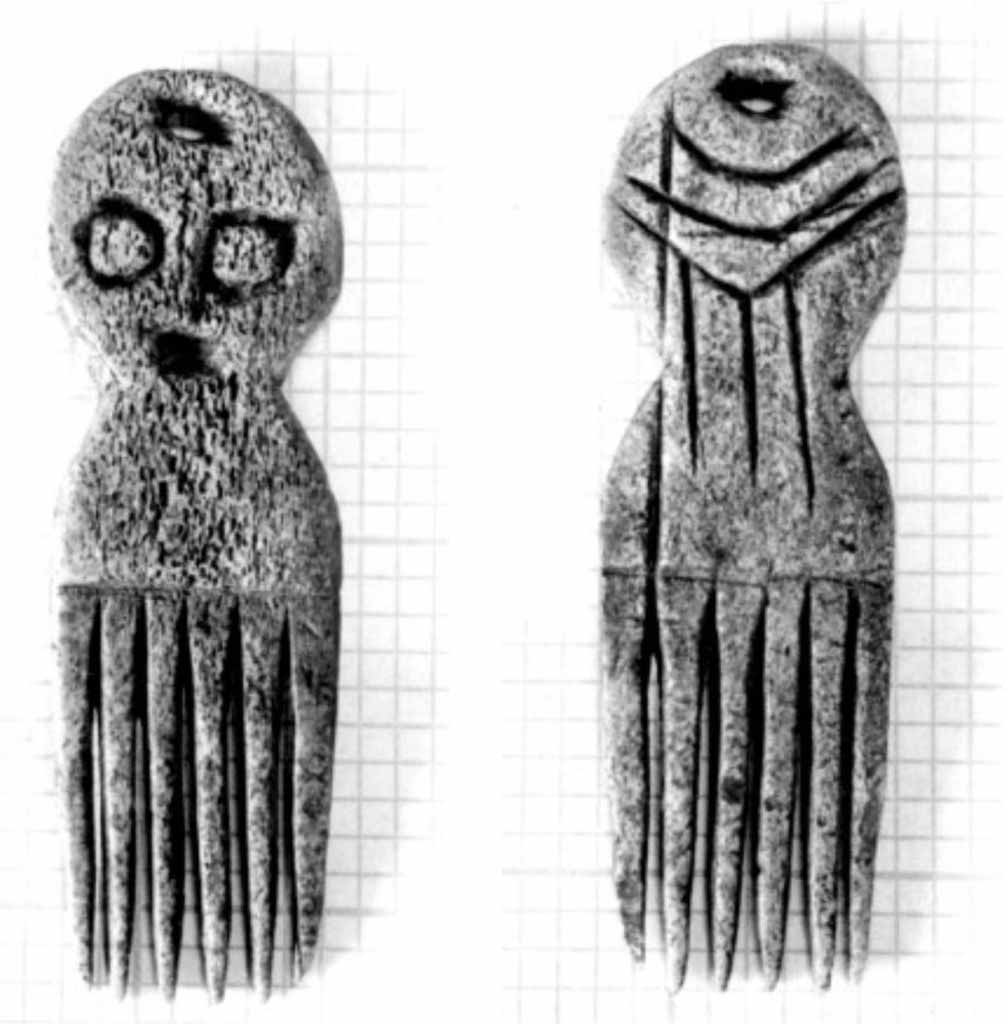
Central Coast
FcTe-4:565. An antler comb with five teeth (Figure 56). All teeth are broken. (L: 71mm; L: from top to teeth 52mm; W: 38mm; Th: 4.5mm). The shaft has an expanding proximal end with an oval hole for an attachment cord. The teeth have cut with a graving tool starting from the lower shaft. The remnants of the teeth show incised lines around each tooth from the manufacturing process. The outer comb is smooth and the inner side has the coarser internal grain structure.

FaTt-9:47. This is a small 4cm long portion of the distal end of a bone comb that is broken off at the base of the shaft. It includes a portion across the teeth that has two complete teeth and one broken. It is highly polished (Figure 57).
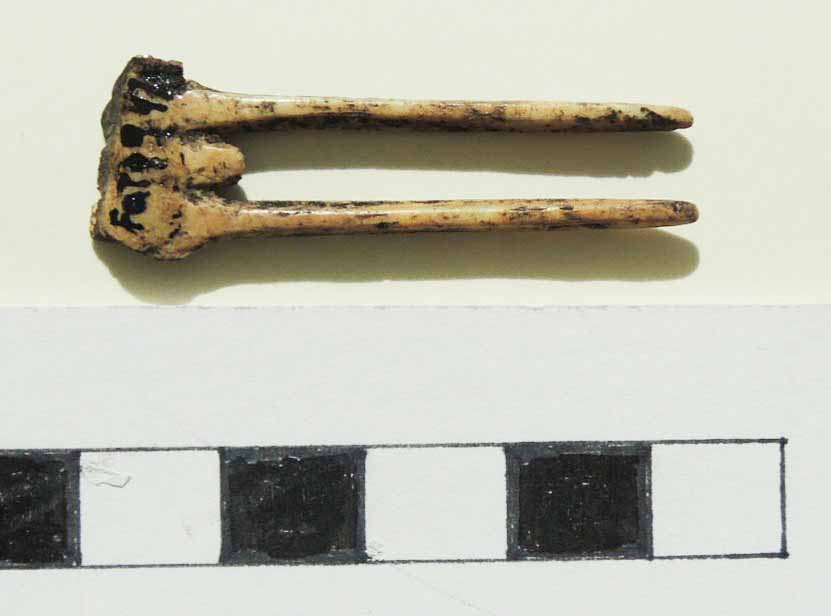
Northern Coast
George McDonald indicates that: “Combs are the most highly decorated of all the artifact classes on the northwest Coast”. Although his generalized chart has combs starting at 500 A.D., he indicates that: “About A.D. 800 the first combs appear which bear the earliest combination of stylistic features that can be considered as classic Northwest Coast style”.
Figure 58, is a caste of GbTo-23:850 from the Garden Island site in Prince Rupert Harbour. Under permit the RBCM was to get a represented sample of artifacts from this site – which resulted in the acquiring of this caste copy. It has five broken teeth. The earliest dated comb with the wolf-like design is said to date to “around 800 A.D.” or in another context a Prince Rupert bone comb (bifacially incised) is “stratigraphically dated to A.D. 800 to 1000 A.D.” (McDonald 1983:102). As he notes there were only four combs of the 20,000 artifacts.
George McDonald shows drawings of two combs GbTo-33:3985 (Figure 59), which “dates somewhat later” with an “otter or lizard” design. It has five broken teeth. Both sides of comb GbT0-34:1805, are “an example of flat design” which is more like more southern designs. It has the remains of six teeth on an elongated shaft with an incised design on both sides (McDonald 1983).
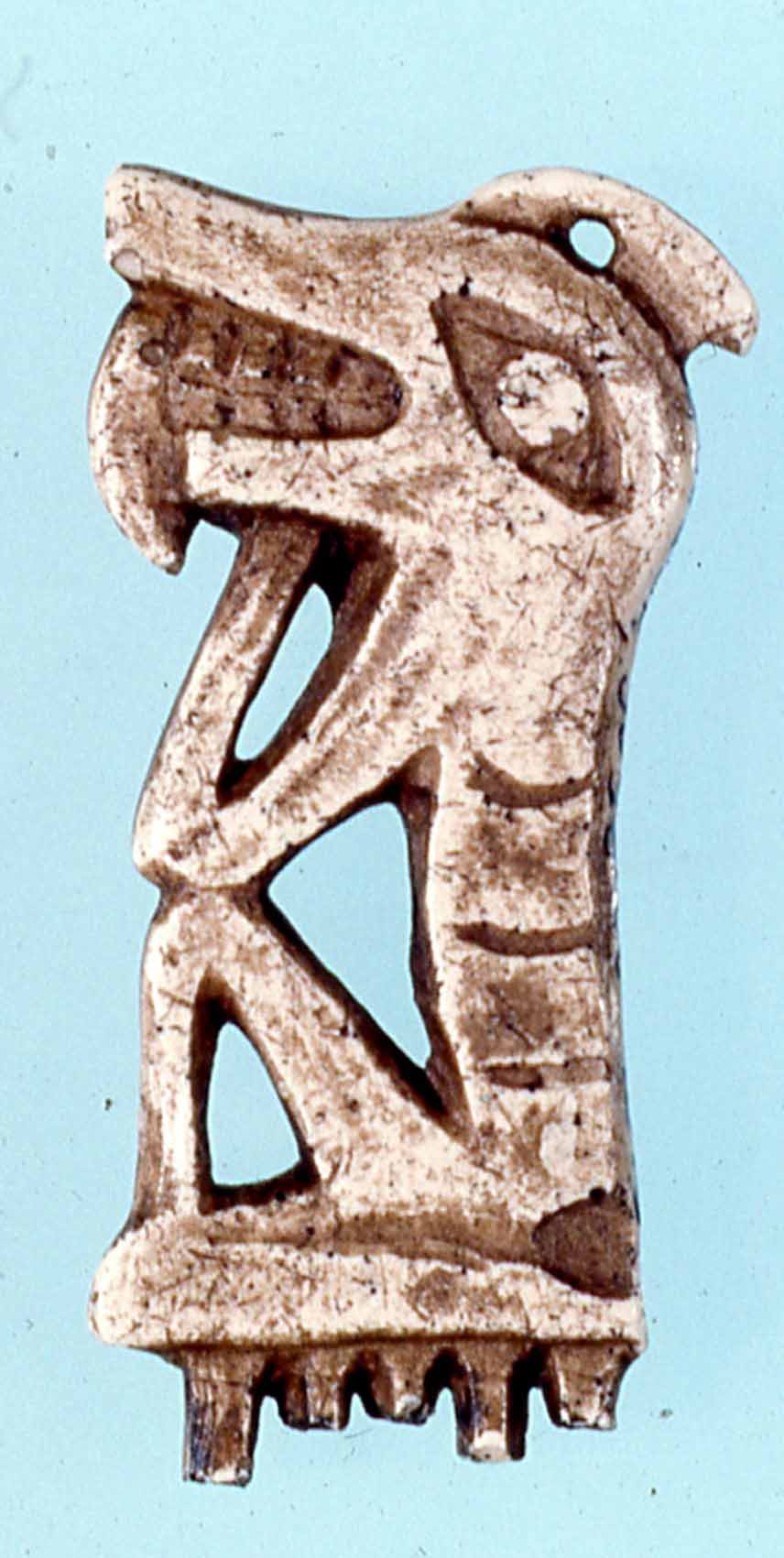
Figure 59, shows two different styles of combs from the Prince Rupert region. On the right, two sides of antler comb from the Kitadach site GbTo-34:805 (Prince Rupert area), dating to c. 950-750 B.P. Six broken teeth. The zoomorphic-like design on the rectangular body has split-U forms, eye forms and T-shapes. Attachment hole in upper body. On the left is an animal shaped comb from site GbTo-33:3985. This comb dates to around 800 A.D.
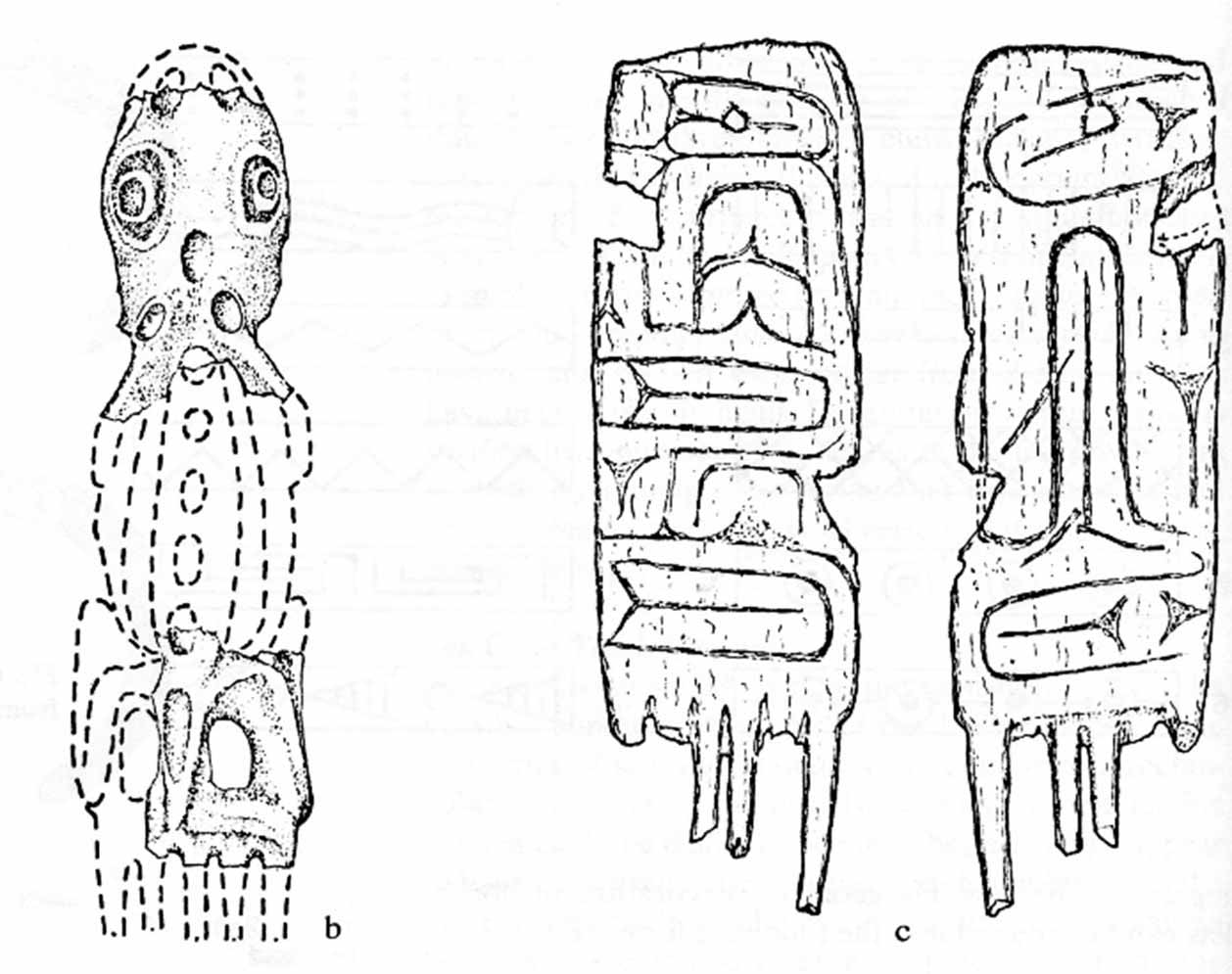
Interior British Columbia
Tahltan antler comb. RBCM Temporary Specimen receipt 9535. Recovered under Permit 2018-0284 of Duncan McLaren of Cordillera Archaeology (Figure 60). Found on mountain top eroding out of ice. Associated with a leather thong with blue trade beads. L:109mm. Width at proximal end of shaft 25mm and 32mm at distal end. 4mm thick at proximal end and 5mm at distal end of shaft. A 3mm suspension hole at proximal end of shaft. 4mm wide line on base of shaft. Eight teeth, longest 42mm. 5 intact and three broken. 3.8mm wide teeth. 11 incised dots across distal end of shaft.
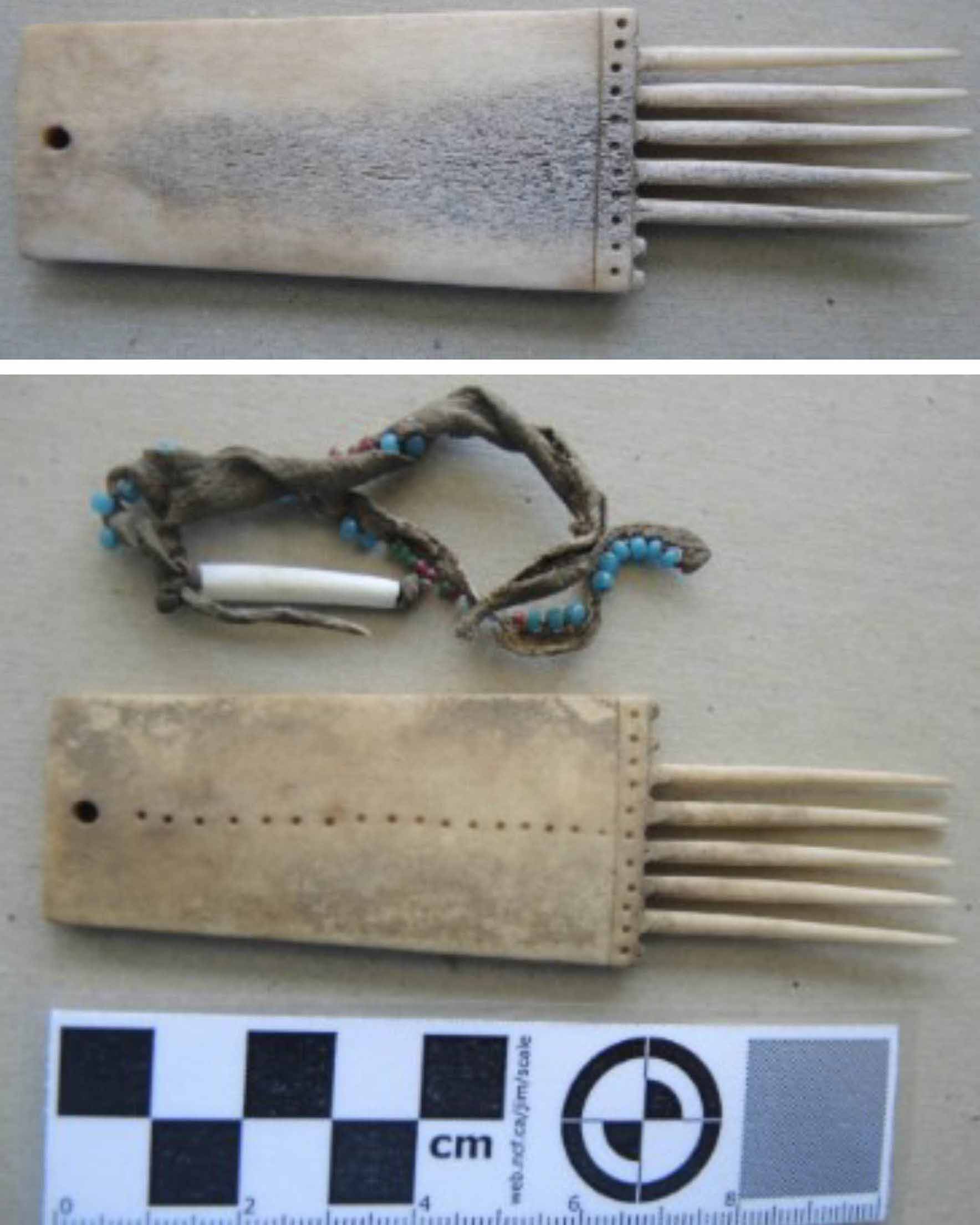
The Bell Site comb. RBCM1981a
From the Bell site, EeRk-4:19-555, near Lillooet (Figure 61). 15.8×4,1×0.54cm. With an infant interment from house pit #19. Six teeth are widely spaced apart. Two unidentified bird figures. Drill holes through each eye and between the legs of the birds. Incised decorative pattern on the body of the comb and across the body of the birds (see Stryd 1981, 1983).
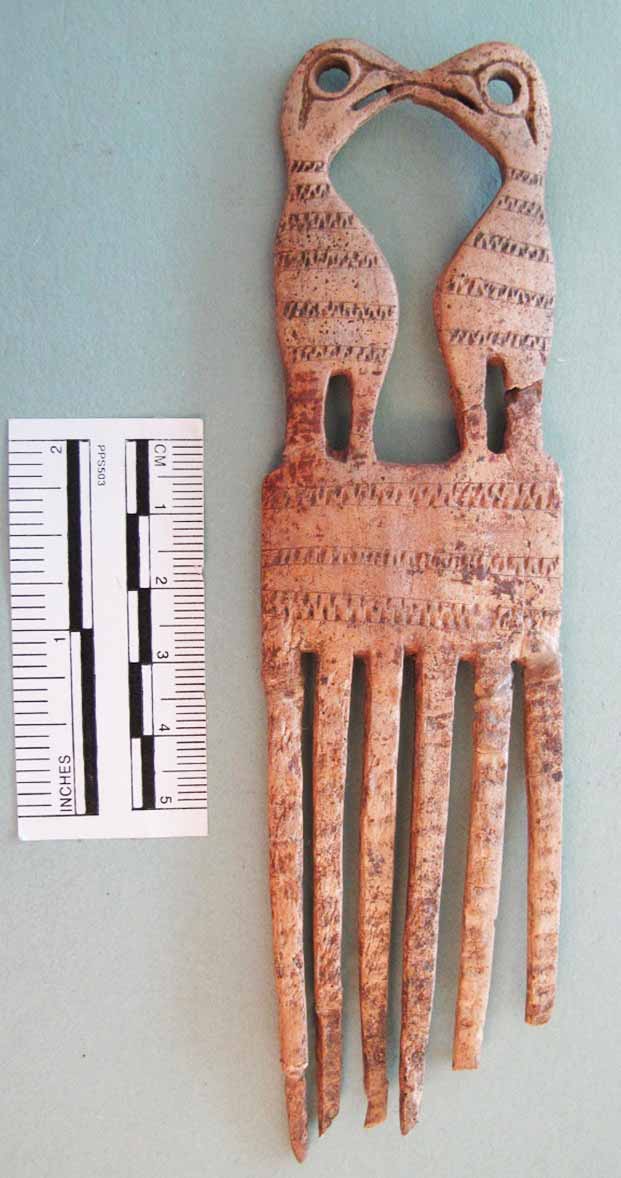
Washington State Combs
The oldest know wooden comb, discovered in a three-thousand-year old wet site on the Hoko River in Washington state, has 13 intricately carved wood teeth twined together at one end (Croes 1995). The comb itself has not been dated.
A unique antler comb was found at the old Tze-whit-zen village site of the Lower Elwha Klallam (Figure 62). It has a rectangular portion of the lower shaft with a cut out on top of two birds on each side of a human figure. Two lines cut across both the upper and lower parts of the shaft. There are eight teeth with one partly broken off. (Gantenbein 2005).
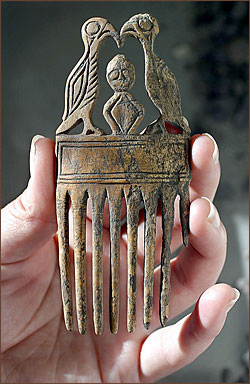
Ozette Village Combs
At least 62 combs were found at the old village site of Ozette on the Olympic Peninsula (Gleeson 1980). Kent (1975) reports 26 made of wood, 20 of bone and 2 of antler. The upper portions of this site have a calibrated date of around 1600 to 1350 B.P. Figure 63, shows the variety of, mostly antler, combs found at Ozette village. At the top centre, is a comb made up of five separate wooden teeth bound together over half its length with wild cherry bark (Gleeson and Grosso 1976).
Daughty and Friedman show two examples of preserved wooden combs and note: “A strong element of geometric ornamentation also can be seen in the art of Ozette, …zig-zag lines, parallel lines and patterns of triangles and crescents ornament combs … “ (Daughty and Friedman 1983).
Two sides of a wood comb has a design that curves around from one side to the other (Figure 63, bottom left). Kirk notes that this comb came from a basket that contained a spindle whorl, 2 combs, awls, bundle of bird bones, wet stone, a lump of red pigment “. She speculates that “apparently this was a weavers bag”. Kirk explains that combs need to be made of wood that had elastic strength and mentions that combs of “dog wood, red berry elder, cascara, Salal and Yew were all suitable”. But there is no information as to whether the wood from any of these were professionally identified. Kirk gives a date from charcoal in a fire hearth as 400 +/- 90. 1613 & 1719 for dendrochronology dates (Kirk 2015).
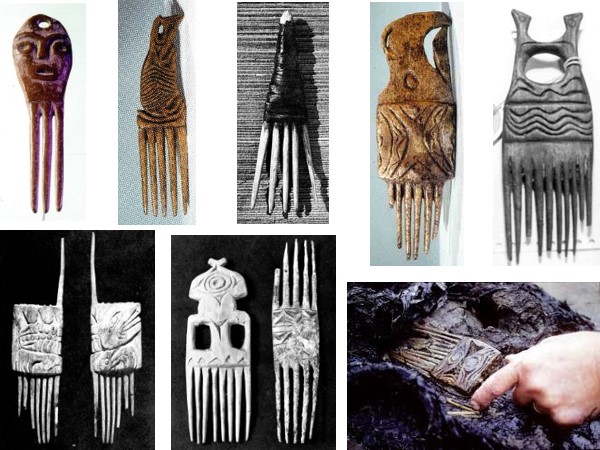
If the comb shown in figure 63, bottom right, is from a “weavers bag” it might be speculated that this double side comb was used as a weaving comb but it would appear that the teeth of the comb would be too long to do this job efficiently.
Bruggmann and Gerber, show a single sided and double-sided comb with geometric patterns (Figure 63, bottom centre) listed as: “deer antler (13cm) and whalebone (14cm)” (Bruggmann & Gerber 1989)
Kirk mentions that in the 1970s: “Makah elders thought women used bone combs for pinning up the braided hair, wooden combs were used for scratching and for combing dog’s hair”. She considered the statement about dog hair as speculation.
McMillan comments on another comb: “One elaborate complete example exhibits a bilaterally asymmetrical handle with two standing wolves facing each other, snout to snout (Huelsbeck and Wessen 1994). The areas under the animals’ heads and between their legs are cut-out spaces. Incised surface designs of zigzag lines cover the animals bodies and two broad bands of zigzag lines embellish the space below the wolves. The short stubby teeth of the comb show the same type of wear striations as the T’ukw’aa example. Another nearly complete comb has human faces carved in low relief on each side (Mckenzie 1974:71-73). A carved oval hole through the artifacts forms the mouth for both faces, while another perforation at the top of the object would allow suspension as a pendant.”
The two artifacts on the upper left of figure 63, are likely hair pins to hold the hair in place. Combs of a similar size are found in cultures further to the south, such as that seen in figure 64, from Oregon (Miles 1963)

Discussion
It is important to be critical of the written work of early authors who have not observed the use of certain combs or did not get the information from experienced comb users in the cultures being referred to. This is also true for the information in Museum catalogues. It might be easy to assume that an item is a hair comb when it was in fact used for something else the writer was not aware of.
The style or way of making objects may have changed in historic times due to the introduction of new technologies and the commercialization of traditional artifacts that are made to sell, rather than for use as part of a tradition society. Many objects in Museum collections are essentially tourist artifacts that were never used as part of a living traditional culture and others that were made as educational models to show traditional objects where they no longer exist.
Cultural Indicators
The early observations of combs on the Northwest Coast indicate that they are social indicators that are meant to be seen. They convey a message, such as the comb in figure 2, that likely links the wearer to a specific family with rights to the Sxwayxwey ceremonies.
An example of this social significance can be seen in the comb from Inupiat culture, figure 65. This example would have linked the wearer to whaling activity. The specific function of this, 5.3cm, walrus ivory comb is not known. During Punik culture times, when whale hunting became an important part of the economy, whale tail effigies began to appear on several types of artifacts. This comb suggests a connection to historically recorded beliefs: “An Inupiat captain’s wife could not wash or comb her hair during the hunt, one of the many prohibitions that emphasized her influence over the whale’s spirit” (Crowell 2009).
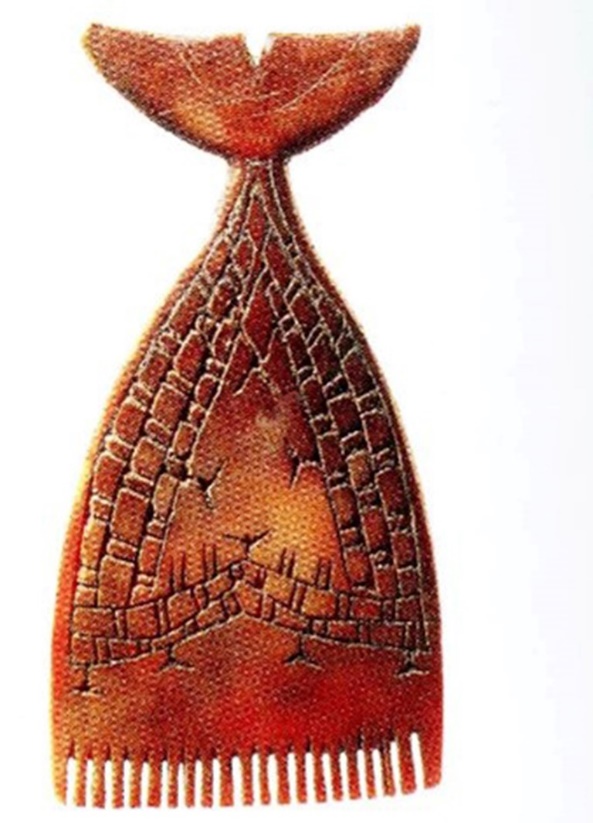
Size may not always be an indicator of how a comb was used in the past. Although one would expect that length of the teeth and the spacing between the teeth would be more suitable for specific activities. In Korea, for example, what we would assume is a flee comb is a fine comb that was used after a regular hair comb was used. The fine-tooth comb called a chambit was used to smooth the hair. For more detailing, smaller combs called ‘myŏnbit’ were used in addition to these regular-sized combs (Torrens 1865).
Regional Changes
There have been regional patterns of types of combs or differences in how they were used on the Northwest Coast. The comb in the British Museum (Am.VAN.218) showing two human figures wearing English style hats, collected on George Vancouver’s voyage in 1791-95, clearly shows that Indigenous individuals saw the business opportunities in the making of combs to trade with ships crews at this early post contact time period.
We see these regional patterns in many other parts of the world. There are, for example, different regional patterns of combs in Indonesian (Figure 66). Tortoise shell combs are a specialty of the Island of Sumba, East of Bali. The Batak of Palawan in the Philippines have fan shaped combs. Ornamentation on combs in this region is often looked upon as having magical power to help in hunting, fishing and farming (Richman 1980). The icons of animals or humans on Northwest Coast combs likely have social meanings beyond simple decoration.

Weaving combs on the Northwest Coast?
The ethnographic information on this topic is minimal, but it is likely that weaving combs may have been used in the past, just as I have suggested is the case for the use of weaving bowls (Keddie 2003). Paul Kane’s account from observations made in 1847, may reflect the last period of the use of weaving combs.
James Teit, in discussing the simple looms used by the women of Spuzzum in 1908, specifically indicates that fingers and not combs are used in weaving at that location (Teit 1908).
The importance of the weaving comb in providing fine blankets, is described by Charles Amsden in his commentary on Navaho weaving. He explains that when weaving, the batten is turned horizontally to hold open the shed and pass the weft threat through. Then: “while the weaver works the weft strands into place with the combing preparatory to pounding it firmly down with the batten”. He explains that the purpose of this is because the comb is: “useful in straightening out the twists and snarls in the weft, and in weaving those last few inches of fabric wherein space is so constricted that the batten has no room for movement” (Amsden 1934). The assumption here is that the finer and even quality of the weaving would not be as good without using a comb in combination with the batten to press the weft into place.
If weaving combs were once common on the Northwest Coast, we need to consider that there may have been changes in styles of weaving combs that varied by region or over time. An example of historic changes in weaving combs can be seen in regional differences in Mexico (Figure 67). Donald and Dorothy Cordry describe the changes that occurred among the Zoque of Chiapas Mexico. For the back loom “two shuttle-rods are used. A small maguey spine constantly serves the weaver for pressing down the weft threads and keeping the warp threads properly spaced. When a fraction of an inch is to be finished and the space will not allow the insertion of even the finest batten, the weaver presses down the weft with one of several kinds of combs. Within the memory of Indigenous consultants, all the old combs were made by the Tzotzil of the region of San Cristobal, who brought them to Tuxtla to sell. These were all well made of small pointed sticks laced together. Formally they were all used as hair combs.
The weaving comb now generally used is made by splitting in two, a fine hair-comb of wood (sometimes imported from Oaxaca) and dulling the teeth so that they will not cut the threads.” (Cordry and Cordry 1941:116). The physical shape between the old and new types is quite different.
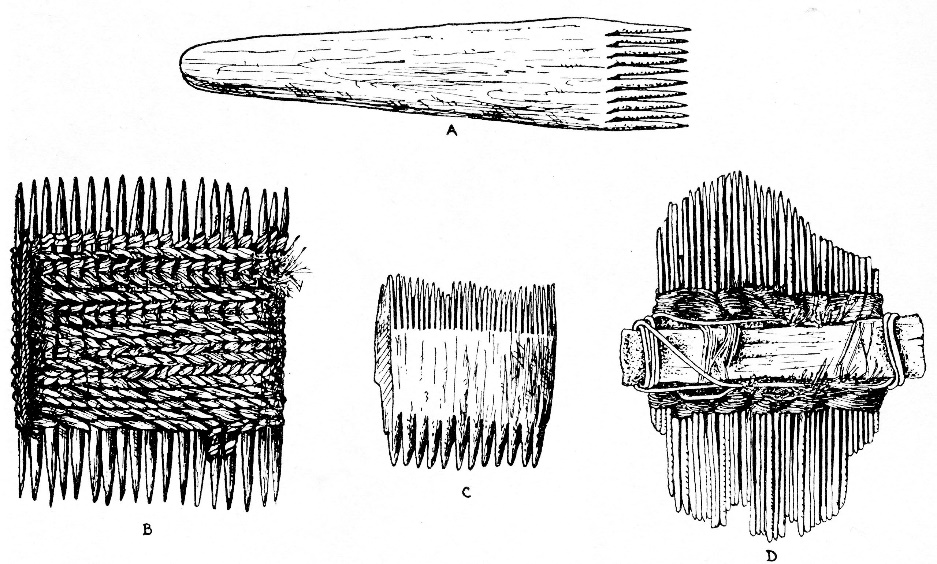
Parasite Combs
There is a greater need for more combs to be found and dated before we can be more specific in identifying the function of combs and changes that occurred through time.
In the future we will be able to identify the function of some combs when we have specific evidence, such as the finding of microscopic lice parts in the back of the teeth of the combs. I have observed organic material on some of the combs in the RBCM ethnology collection.
Examples of research from other parts of the world include the discovery of head lice in debris among two sided wooden combs excavated in Egypt’s Coptic Period 500 to 1000 A.D. (Figure 69) and from Egypt dating between the fifth and sixth centuries A.D. (Figure 68). Palma examined both sides of the latter comb from Antinoe Egypt, in the collections of the National Museum of New Zealand. No lice, either whole or broken, were found in the debris from the coarser side of the comb (2-5 teeth per cm) with shorter and more widely spaced teeth, but debris extracted from the finer side of the comb (6 teeth per cm) with longer and finer teeth contained the remains of seven specimens of head lice. “Modern combs differ very little in shape and dimensions from their ancient counterparts, and they are still regarded as among the most effective, and indeed the safest, methods of head lice control” (Palma 1991).
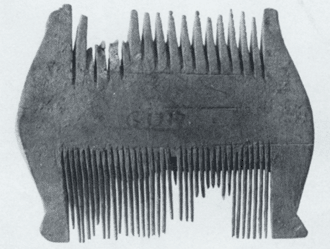

One of the oldest examples of a comb that can be identified as a parasite comb is a 3700 year old ivory flee comb, excavated in Israel (Figure 70). Inscribed on the comb is the earliest known full sentence Canaanite alphabetic script. The incised script translates as: “May this tusk root out the lice of the hair and the beard”. Although it is partly broken, it appears to have had 14 short teeth similar to the Egypt comb shown in figure 68.
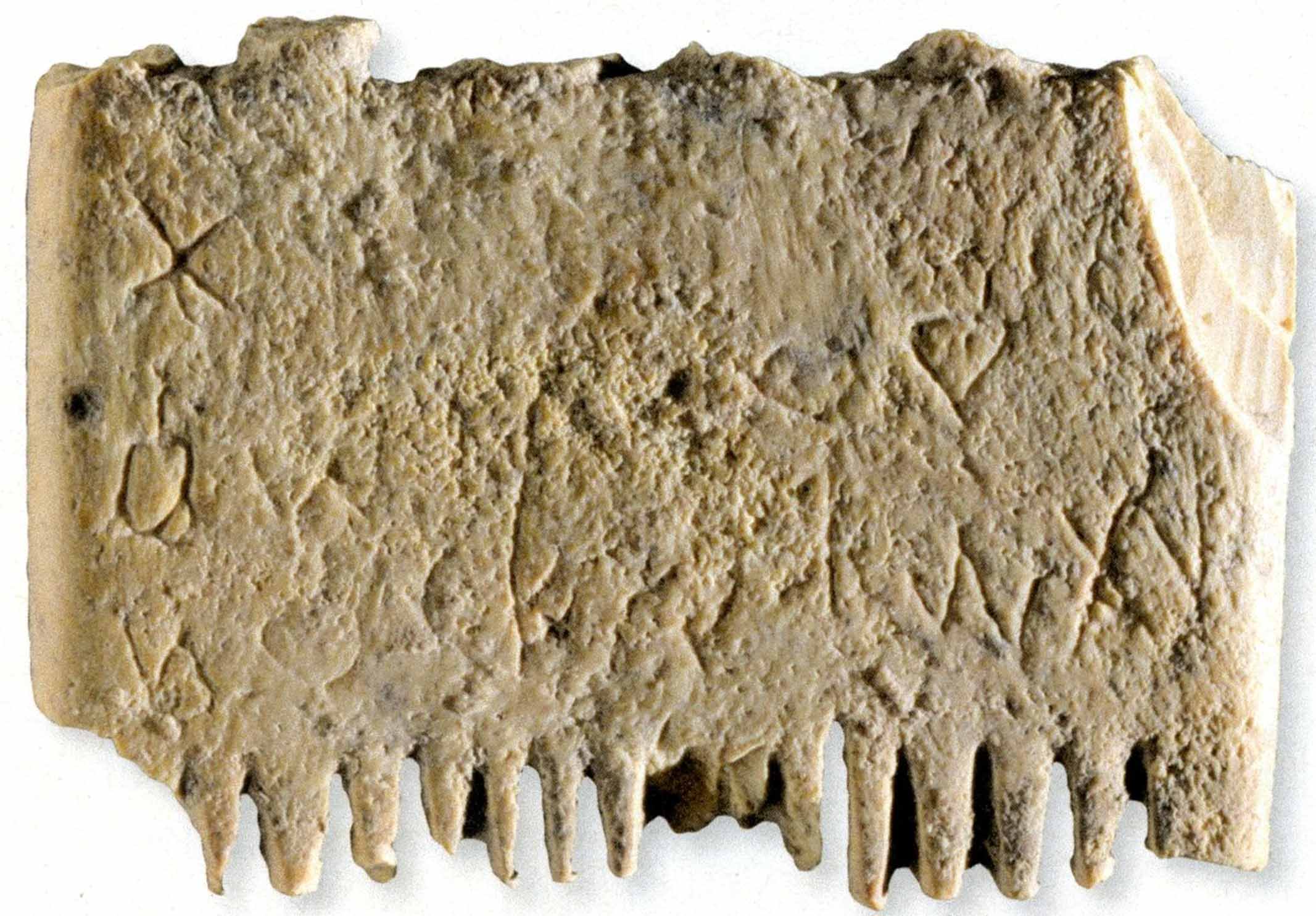
Double sided flee combs were found among cultures of the Atacama Desert of Chile dating to between 240 to 800 B.P. As they were found with the burials of women it was previously assumed that they must be related to weaving activities. But more than half of them contained the remains of lice, eggs and fleas. No other inclusions, such as textile fibres, were found (Adauto et. al. 2011; Arriaza et. al. 2014; Ascunce et. al.2023; Reinhard et. al. 2023).

Processing Fibrous Materials
As noted, I have found only a few written accounts of combs being used for processing fibrous material such as stinging nettle (Boas 1890; Curtis 1913). But I have found from my own experimenting that combing semi-prepared stinging nettle works well. This kind of material processing does not create the encircling grooves on the teeth of combs. The latter marks are likely the results of the use of the scouring rush or horsetail (Equisetum hyemale) plant. This plant has conspicuous ridges, which are impregnated with silica which serves as a cutting agent. Dried strips of the plant are rolled back and forth around a comb’s teeth, after they have been roughly graved out with a stone or (later) iron tool.
In the future, combs that have been used for berry picking may be identified with dna or isotope analysis if they are found in waterlogged sites or in dry cave sites.
Comparison to Combs of Siberia.
Moszynska reports that antler combs from Ust-Poluy in Sibera are all high, with long, wide, relatively sparse teeth. In the Ob region of the Ob Ugrians hunting and fishing economy, only in a few cases is the upper part of the comb not decorated. Most images represented are birds of prey and deer. Teeth vary from three to 14, but five being more typical. High combs (Figure 72, left side) for pinning the hair, with sculptured handles, are known in several territories distant from each other. These combs are 74mm – 124mm in height and the length of teeth 53-60mm. He notes hair combs rather than pinning combs among Innuit sites (Moszynska 1974)
Derevyanko shows an antler comb from the second millennium B.C. bronze age Krotov culture (Figure 72 – centre) which exhibits the same grooved manufacturing markers on the teeth as some British Columbia combs (Derevyanko 1986).
A Herschel Island Inuit house site dating to c. 1620 A.D. had a portion of a baleen comb that was longer at c. 134mm. It was decorated with a ticked line on each face and a deep v-shaped cleft in the handle. A rectangular antler comb with 8 teeth was 68mm high by 23mm wide (Friesen & Hunston, 1994).
Dikov shows a double ended comb with 12 closely spaced teeth on one side and five broken more widely spaced teeth on the other side (Figure 72, right side). The shaft has a geometric design cut into one side and has four circle and dot motifs engraved into each side. This is from a late period site on the southern tip of the Kamchatka Peninsula. Only a recent date was obtained for the late period at Lopatka 1 (380+/-50, MAG-315). The older cultural layer II at Lopatka Point 1 has a radio carbon date of 2,200 +/- 100 B.P. (MAG-313). Similar assemblages to the Lopatka Point 1 culture includes dates that range from 950+/-70 to 570+/-40 at two other shellmidden sites in the area (Dikov 1983).
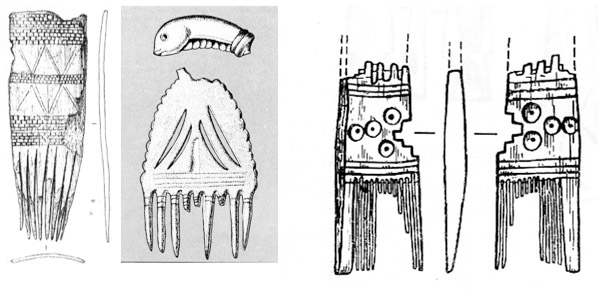
Figure 73, is a mammoth ivory comb from Yakutia, Siberia. MAE No. 4282-171. (7.4 X 6.3cm. Teeth 1.8cm long).
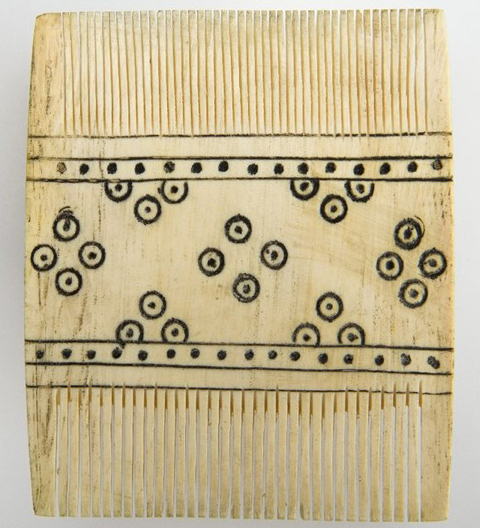
Leroi-Gourhan (1946), demonstrates examples of combs from the Kuril Islands between Kamschatka and Japan (Figure 74).

Appendix 1.
“Salish” Combs in the Perth Museum.
There are five cutout figure bone combs in the Perth Museum which are described as being “Salish” from the Northwest Coast (Figure 75), These were donated with artifacts recorded as being from the “Fraser’s River, Gulf of Georgia, but with minimum provenance given. I provide a new revue of these and determine that they are not from the Northwest Coast. These are unique in being collected in 1828 and donated in 1835, earlier than most comb accessions from the 19th century.
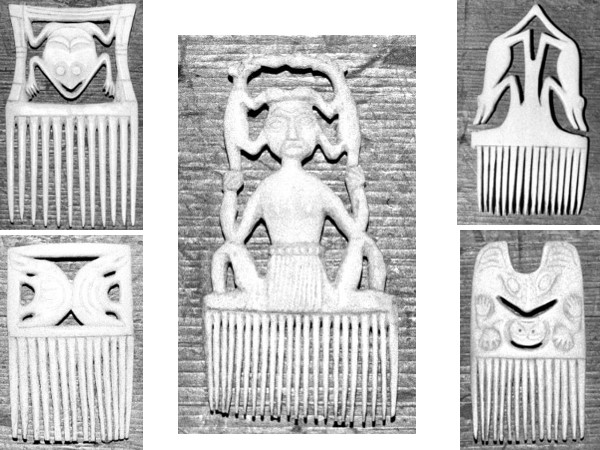
Colin Robertson (1783-1842) of the Northwest Company and Hudson’s Bay Company donated the five bone combs in 1835, to the Perth Museum (Ms 1468; Selkirk Papers; Acc. Nos. 1978.484.484-488). Robinson was born in Perth and sent a number of “Curiosities from Fraser’s River, Gulf of Georgia” to the Literary and Antiquarian Society of Perth in 1833 (Idiens 1978)
The largest comb, 1978-488 (10.5cm by 6.3cm), is a sitting woman holding two four legged animals by the tail on each side of her head with their front legs resting on her head (Figure 75 – centre). The animals have four legs, are facing each other, and have large bulbous material coming out their mouths. The latter reminds me of the myth in India about the two mongoose vomiting jewels.
The Perth Museum, 1978-485, has two creatures that do resemble the side view of a mongoose more than any other member of the mustelid family, but mongoose do not occur in British Columbia. The creatures may be a fatter version of the same animals in comb 1978-484, which have similar heads. However, see my comments below on the Perth combs.
Comb 1978-487, has a human head and two human hands below the open mouth of a creature whose five-digit claws are below the human hands. This is reminiscent of some northern Northwest wooden figures with the theme of a bear eating a human, but the mouth of the creature above is more like that of the mouth of the frog image 1978-486.
One comb similar to the style of the sitting woman comb is AN00914276_001 (old Acc. No. 6434), in the British Museum collected by Julius L. Brenchley (figure 76). It has a sitting person holding their braided hair on each side, the pattern of which resembles a snake. Another in the form of a standing man collected by the same man (Benchley collection, no. 604) is in the Maidstone Museum and Art Gallery in Kent, England. Brenchley traveled the world starting in 1845 for 28 years. The collection was bequeathed to the Museum in 1873.
Another similar comb to Perth Museum comb 1978.4854, with an open cut pattern and two lightning snakes or mustalid-like creatures, on each side facing each other, but in the opposite direction, is found in the Burke Museum. This artifact number 1989-57/16-P1-1 (8.5cm x 6.6cm) is listed as being from “Neah Bay, Clallam Country”. The later has ten teeth. It was donated as late as 1989, making it difficult to pin down its age.
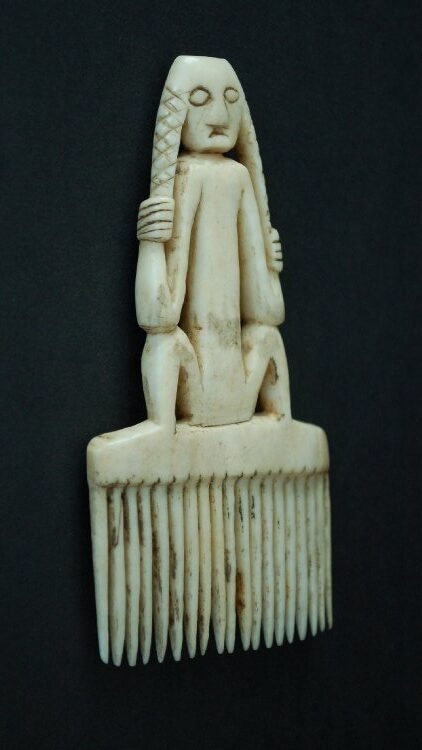
Comments on Perth Museum Combs
Dale Idiens, then assistant Keeper, at the Perth Museum sent photographs and commented about these combs in a letter of November 20, 1978, to Peter Macnair, the Royal B.C. Museum curator of ethnology: “The series of ivory combs and the model canoes with figures are unlike anything I have seen before – do you know of parallels?” (Idiens 1978).
Peter McNair thought these combs were unusual, especially being made of bone, and brought them to the author for my opinion. I also thought there was something unusual about these combs – all being made of a light-coloured bone and having a similar ambiance about them, which suggested they may have all been made by the same person, or related people, near the same time.
Peter Macnair, could not see any alternative as to the nature of these combs, and so several months later, commented on the bone combs in a letter to Dale Idiens: “I would attribute these as Salish. I know of no bone examples but I have seen somewhat similar combs in wood. The iconography further suggests a Salish origin to me. The stylized animals seen of three of the examples are strongly reminiscent of similar forms on Salish combs, spindle whorls and other artifacts related to weaving. Such creatures are generally considered to be mustalids.”
Later, in 1987, Dale Idiens observed that the Perth Museum combs are “a most unusual series of five antler or bone combs carved with animals and human figures. These examples are smaller than many Salish wooden combs, and while there are formal similarities in the shape of the animals, the U-forms characteristic of many wooden combs are absent” (Idiens 1987).
The Perth Museum combs, in fact, strongly resemble bone combs from eastern Canada found among ethnic populations such as the Senica Iroquois (Figure 78). Colin Robertson, who donated the combs, lived in eastern Canada and was never in British Columba. However, he was known to have members of the Hudson’s Bay company, working on the West Coast, send him ethnographic artifacts.
Although I saw some of the similarities in the Perth combs as Peter Mcnair, specifically with the frog image in the upper left and lower right combs in figure 75, I looked into the possibility that one of the fur trade companies was having trade combs of an Eastern Canada ethnic style made in India or elsewhere for the North American fur trade. India, via the East India Company, developed their industries for making ivory, bone and horn items in the 18th and 19th century (Willis 1998; Panchanand 1965; Arasaratnam 1967), but I could not find any examples that resembled trade combs that were a known part of the North American fur trade. Figure 77, shows an example of a bone comb made in Sambhal district of Uttar Pradesh state in Indian with a design resembling the lightning snake on the southwest coast of British Columbia, swallowing its tail. Bones and horns of animals are manufactured in different parts of India, but Sambhal is a major centre for their production – which are mainly for export. The practice goes back at least 200 years. Hand made combs from the local community of Sarai Tareen are famous and in more recent times supplied much of India.
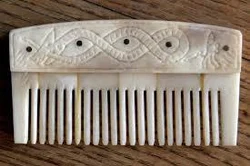
Four years after the Robertson combs were collected, there were 104 “ivory combs” ordered for Fort Union on the upper Missouri by the American Fur Trade Company (Thompson 1968:140), but I could not find any images of what these looked like. I suspect that the “ivory combs” were actually made of bone.
The comb in the top left side in figure 75 is clearly a replica from the same source as the Iroquois example in the lower right of figure 78. The Perth Museum combs are not from the coast of British Columbia and appear to be made in Eastern Canada – unless further research can find that they came from a manufacturing location somewhere else where bone combs were being made for the Fur Trade.
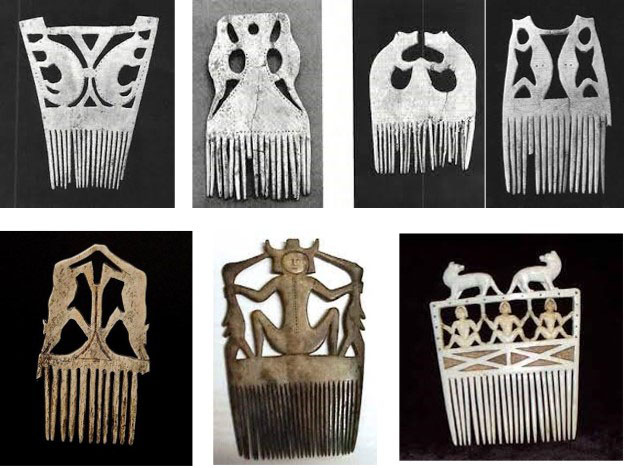
References
Amsden, Charles Avery. 1934. Navaho Weaving. Its Technic and Its History. Southwest Museum. Fine Arts Press. Santa Ana, California.
Arasaratnam, S. 1967. The Dutch East India Company and its Coromandel Trade 1700-1740. Deel 123, 3de Afl.pp.325-346.
Araujo, A, K. Reinhard, D. Leles, L, Slanto, A.M. Iniguez. 2011. Paleoepidemiology of Intestinal Parasites and Lise in Pre-Columiban South America. University of Nebraska, Lincoln.
Arriaza, Bernardo, Vivien G. Staden, Jorg Heukelbach et. al. 2014. Head Combs for Delousing in Ancient Arican Populations: Scratching for the Evidence, Chungara (Arica) 46(4):693-706.
Ascunce, Marina S.; Toloza, Ariel C.; Gonzalez-Oliver, Angelic; Reed, David L. et.al. 2023. Nuclear genetic diversity of head lice sheds light on human dispersal around the world. PLoS One; 18(11):e)293409.
Barnett, Homer Garner. 1939. Cultural Element Distributions: Gulf of Georgia Salish. Anthropology Records of the University of California. University of California Press.
Barnett, Homer Garner. 1955. The Coast Salish of British Columbia. University of Oregon.
Bergan, H.G. 1989. The Bergen Collection Manuscript file at the Burke Museum, University of Washington, Seattle.
Bergan, H.G. 1959. Unusual Artifacts. Screenings 8(4).
Bernick, Kathryn. 1989. Water Hazard (DgRs-30) Artifact Recovery
Project Report. Permit 1988-55. Laboratory of Archaeology
Department of Anthropology and Sociology University of British Columbia. Submitted to the Archaeology and Outdoor Recreation Branch Ministry of Municipal Affairs, Recreation and Culture Province of British Columbia.
Boas, Franz. 1909. The Kwakiutl Indians of Northern Vancouver Island.
Boas, Franz. 1916. Tsimshian Mythology. Thirty-First Annual Report of the Bureau of American Ethnology. To the Secretary of the Smithsonian Institution. 1909-1910. Washington, Government Printing Press.
Borden, Charles E. 1983. Prehistoric Art of the Lower Fraser Region. In: Indian Art Traditions of the Northwest Coast. (ed) Roy L. Carlson. Pp131-165. Simon Fraser Press. Department of Archaeology Simon Fraser University
Brown, Robert. 1869. In Pawn in an Indian Village – II. In: Illustrated Travels: A Record of Discovery, Geography, and Adventure. London, Cassel, Petter and Galpin.
Bruggmann, Maxiilien and Peter Gerber. 1989. Indians of the Northwest Coast. Translater by Barbara Fritzemmeier. Facts on File Publications.
Carlson, Roy. 2005. Images of pre-contact Northwest Coast Masks. American Indian Art Magazine. Spring 2005. Vol. 30, No. 2.
Cordry, Ronald Bush and Dorothy Cordry. 1941. Costumes and Weaving of the Zoque Indians of Chiapas, Mexico. Southwest Museum Papers. Number Fifteen. Southwest Museum, Los Angeles, California.
Croes, Dale R., 1995. The Hoko River Archaeological Site Complex. The Wet/Dry Site (45CA213). 3000-1700 B.P. Washington State University Press, Pullman, WA.
Crowell, Aron L. 2009. Sea Mammals in Art, Ceremony, and Belief: Knowledge Shared by Yupik and Inupiaq Elders, pp 206-225. In: Fitzhugh, William W., Julie Hollowell and Aron L. Crowell. (Editors). Grifts From the Ancestors. Ancient Ivories of Bering Strait. Princeton University Art Museum. Yale University Press.
Chapman, Nancy J. 1969. The Ethnobotany of the Coast Salish Indians of Vancouver Island. A Thesis Submitted in Partial Fulfillment of the Requirements for the Honours Degree of Bachelor of Science in the Department of Biology, University of Victoria, April, 1969.
Chernetsov, V.N. and W. Moszynska. 1974. Prehistory of Western Siberia. Edited by Henry N. Michael. Arctic Institute of North America. McGill-Queens University Press, Montreal.
Curtis, Edward S. 1913. The Salish Indians. Volume 9. The North American Indian. Being A series of Volumes Picturing And Describing The Indians of the United States, The Dominion of Canada, and Alaska. Edited by Frederick Webb Hodge. Norwood Mass.; Plimpton Press. (Reprinted: Johnson Reprint, New York, 1970).
Daugherty, Richard and Janet Friedman. 1983. An Introduction to Ozette Art. In: Roy L. Carlson (ed), Indian Art Traditions of the Northwest Coast, Archaeology Press. Simon Fraser University, Burnaby, B.C. pp.183-195.
De Laguna, Fredericka. 1972.Under Mount Saint Elias: The History and culture of the Yakutat Tlingit. Smithsonian Contributions to Anthropology. Washington.
Derevyanko, A. 1986.Through the Shroud of the Millennia. Science in the USSR. 1986:3:119-127.
Dikov, Tamapa M. 1983. South Kamchatka Archaeology in Connection with the Ainu Occupation Problem. Nauka Publishing House, Moscow.
Drucker, Phillip. 1951. The Northern and Central Nootka tribes. Smithsonian Institution. Bureau of American Ethnology Bulletin 133. Washington.
Ells, Myron. 1986. The Indians of Puget Sound: The Notebooks of Myron Eells. Edited by George Pierre Castle. Whitman College.
Emmons, George Thornton. 1991. The Tlingit Indians. George Thornton Emmons. Edited with additions by Frederica Laguna and a biography by Jean Low. American Museum of Natural History. Douglas and McIntyre, Vancouver/Toronto
Frieson, T. Max and Jeffrey Hunston. 1994. Washout – The Final Chapter: 1985-86 NOGAP Salvage Excavations on Herschel Island. Pp. 39-60. In: Canadian Archaeological Association Occasional Paper No. 2. Bridges Across Time: The NOGAP Archaeological Project. Edited by Jean-Luc Pilon.
Frieson, T. Max. 1994. The Qikiqtqruk Archaeological Project 1990-92: Preliminary Results of Archaeological Investigations on Herschel Island, Northern Yukon Territory, pp. 61-83. In: Canadian Archaeological Association Occasional Paper No. 2/ Bridges Across Time: The NOGAP Archaeological Project. Edited by Jean-Luc Pilon.
Gantenbein, Douglas. 2005. Graving Yard, Graveyard. American Archaeology 8:2:13-18.
Gerber, Peter R. 1989. Indians of the Nothwest Coast. Photographs by Maximilien Bruggmann. Facts on the File publications, New York.
Gerdts, Donna B. (ed) 1997. Hul’q’umi’num’ words. An English-to- Hul’q’umi’num’ and Hul’q’umi’num’-to-English Dictionary. Prepared for the Chemainus, Nanaimo, and Nanoose First Nations and Nanaimo School District No. 68.
Gleeson, Paul. 1980. Ozette Archaeological Project, Interim final report, Phase XIII. Washinton Archaeological Research Centre, Washington State University, Pullman. Project Report 97.
Gleeson, Paul and Gerrold Grosso. 1976. Ozette Site. In: The Excavation of Water Saturate Archaeological Sites (wet sites) on the Northwest Coast of North America. National Museum of Man Mercury Series, 50:13-44.
Gunther, Erma. 1966. Art in the Life of the Northwest Coast Indians. With a Catalogue of the Rasmussen Collection of Northwest Indian Art at The Portland Museum. Published by The Portland Art Museum.
Haydon, Brian and Rick Schulting. 1997. The Plateau Interaction Sphere and Late Prehistoric Cultural Complexity.
Haeberlin, Hermann and Erma Gunther, 1930. The Indians of Puget Sound. University of Washington Pub lications in Anthropology, 4(1)1-84. University of Washington Press.
Huelsbeck, David R. and Gary C. Wessen. 1994. Twenty Five Years of Fauna Analysis at Ozette. In: Ozette Archaeological Research Reports. Vol. 2, Fauna, Edited by Stephen R. Samuels. Reports of Investigations 66.. Pullam, Department of Anthropology, Washington State University. Seattle, National Park Service.
Idiens, Dale. 1978. Letter to Peter Macnair of the Royal B.C. Museum, November 20, 1978.
Idiens, Dale. 1987. Northwest Coast Artifacts in the Perth Museum & Art Gallery. The Colin Robertson Collection. American Art Museum 13:1:46-53.
Jenness, Diamond. C.1934-36. The Saanich Indians of Vancouver Island. Canadian Museum of History Ms #1103-6.
Kaeppler, Adrienne L. 1978. “Artificial Curiosities” An Exposition of Native Manufactures. Collected on the Three Pacific Voyages of Captain James Cook, R.N. Bishop Museum Press, Honolulu Hawaii.
Keddie, Grant 2003. A New Look at Northwest Coast Stone Bowls. In: Archaeology of Coastal British Columbia. Essays in Honour of Professor Philip M. Hobler. Edited by Roy L. Carlson. Archaeology Press, Simon Fraser University, Burnaby, B.C. pp.156-174.
Kent, Susan. 1975. An Analysis of Northwest Coast Combs with Special Emphasis on those from Ozette. Thesis, Washington State University Library, Archives and Special Collections.
King, James. 1784. A Voyage to the Pacific Ocean in the Years 1776, 1777, 1778, 1779, and 1780. Vol. 3. 1784. London.
Kidder, Alfred Vincent. 1932.The Artifacts of Pecos. New Haven, Yale University Press. P1-314. Robert S. Peabody Foundation for Archaeology.
Kirk, Ruth 2015. Ozette. Excavating a Makah Whaling Village. University of Washington Press, Seattle.
Koppert, Vincent A. 1930. Contributions to Clayoquot Ethnology. The Catholic University of America. Anthropological Series No. 1. The Catholic University of America, Washington, D.C.
Leroi-Gourhan, Andre. 1946. Archeologie Du Pacific-Nord Material Pour Petude des Relations entre les Peuples Riverains D’Asiwet et D;Amerique. Musee de L’homme. Paris.
Malloy, Mary. 2000. Souvenirs of the Fur Trade. Northwest Coast Indian Art and Artifacts. Collected by American Mariners 1788-1844. Peabody Museum of Archaeology and Ethnology, Harvard University, p. 94-95.
Malloy, Mary. 1998. “Boston Men” on the Northwest Coast: The American Maritime Fur Trade 1788-1844. The Limestone Press, Kingston Ontario. Fairbanks, Alaska Distributed by the University of Alaska Press.
McDonald, George. 1983. Prehistoric Art of the Northwest Coast. In: Indian Art Traditions of the Northwest Coast. Edited by Roy L. Carlson. Pp.99-120. Archaeology Press, Simon Fraser University, Burnaby, B.C.
McKenzie, Kathleen H, 1974. Ozett Prehistory – Prelude. M.AS. thesis. Department of Archaeology, University of Calgary.
McMillan, Alan D. 2019. Non-Human Whalers in Nuu-chan-nulth Art and Ritual: Reappraising Orca in Archaeological Context. Cambridge Archaeological Journal. 29:2:309-326. McDonald Institute for Archaeological Research University of Cambridge. Cambridge University Press.
McMillan, Alan D. Early Nuu-chah-nulth Art and Adornment. 2000. In: Nuu-Cah-Nulth Voices, Histories, Objects & Journeys. Edited by Alan Hoover, Royal British Columbia Museum, pp. 230-256.
McMillan, Alan D. 2019. Non-Human Whalers in Nuu-chan-nulth Art and Ritual: Reappraising Orca in Archaeological Context. Cambridge Archaeological Journal. 29:2:309-326. McDonald Institute for Archaeological Research University of Cambridge. Cambridge University Press.
McMillan, Alan D. Early Nuu-chah-nulth Art and Adornment. 2000. In: Nuu-Cah-Nulth Voices, Histories, Objects & Journeys. Edited by Alan Hoover, Royal British Columbia Museum, pp. 230-256.
McMillan, Alan D. and Denis E. St. Claire. 2005. Ts’ishaa: Archaeology and Ethnology of a Nuu-Chah-nulth Origin Site in Barkley Sound. Archaeology Press, SFU, 2005.
McMillan, Alan D. 1998a Changing Views of Nuu-chah-nulth Culture History: Evidence of Population Replacement in Barkley Sound. Canadian Journal of Archaeology 22(1): 5–18.
McMillan, Alan D. 1998b West Coast Culture Type. In Archaeology of Prehistoric Native America, edited by Guy Gibbon, pp. 879–881. Garland Publishing, NY.
McMillan, Alan D. 1999. Since the Time of the Transformers: The Ancient Heritage of the Nuu-chah-nulth, Ditidaht, and Makah. UBC Press, Vancouver.
McMillan, Alan D. 1996. The Toquaht Archaeological Project: Report on the 1996 Field Season. Unpublished Report Submitted to the Toquaht Nation, Ucluelet, and the B.C. Heritage Trust and Archaeology Branch, Victoria.
McMillan, Alan D., Gregory G. Monks and Denis E. St. Claire. 2023. The Toquaht Archaeological Project. Research at T’ukw’a, a Nuu-chah-nulth village and defensive site in Barley Sound, Western Vancouver Island. Bar International Series 3135. BRA Publishing, Oxford, UK.
Merk, Frederick (ed). 1931. Fur Trade and Empire. George Simpson’s Journal. Cambridge. Harvard University Press, London: Humphrey Milford.
Miles, Charles. 1963. Indian and Eskimo Artifacts of North America. Bonanza Books, New York.
Millenia Research. 1992. Archaeological Impact Assessment of a Proposed Redevelopment of 10661 Blue Heron Road, Lot 2, Section 17, Range 2 East, North Saanich. DeRu-1. Report to the B.C. Archaeology Branch. Permit 1992-26.
Montler, Timothy. 1991. Saanich, North Straits Salish Classified Word List. Canadian Ethnological Service. Paper No. 119. Mercury Series. Canadian Museum of Civilization. Hull, Quebec
Morice, Rev. A. G. 1893. Notes. Archaeological, Industrial and Sociological on the Western Denes with an Ethnological of the same. Transaction of The Canadian institute Session 1892-93.
Moszynska, W. 1974. The Material Culture and Economy of Ust-Poluy. Pp. 77-111. In: Prehistory of Western Siberia, V.N. Chernetsov and W. Moszynska, Edited by Henry N. Michael. Artic Institute of North America. McGill-Queen’s University Press, Montreal and London.
Mumcuoglu Y.K and J. Zias, ‘Head lice, Pediculus humanus capitis (Anoplura: Pediculidae) from hair combs excavated in Israel and dated from the first century B.C. to the eighth century A.D.’ Journal of Medical Entomology 25 (1988),545-7.
Palma, Richardo L. Old Comb Reveals Nits on the Nile. Ancient head lice on a wooden comb from Antinoe, Egypt. The Journal of Egyptian Archaeology, Volume 77, 1991
Panchanand, Misra. 1965. A Century of Indo-American Trade Relation 1783-1881. Proceedings of the Indian History Congress. Vol. 27:351-358.
Portlock, Nathaniel. 1789. A Voyage Round the World. But more particularly to the North-West Coast of America: Performed in 1785, 1786, 1787, and 1788, in the King George and Queen Charlotte, Captains Portlock and Dixon. London: John Stockdale and George Goulding, London.
Richman, Rita. 1980. Decorative Household Objects in Indonesia. Arts in Asia, September to October, pp.130-134.
Reinhard, Karl, Nicole Searcey, Elisa Pucu, Bernardo Arriaza, Jane Buikstra, Bruce Owen. 2023. HEAD LOUSE PALEOEPIDEMIOLOGY IN THE OSMORE RIVER VALLEY, SOUTHERN PERU. Journal of Parasitology. 109(5):450-463.
Ruby, Robert H. and John A. Brown. 1976. Myron Eells and the Puget Sound Indians. Superior Publishing Company. Seattle, Washington.
Smith, Harlan I. 1903. Shell Heaps of the Lower Fraser River British Columbia. Memoirs of the American Museum of Natural History. The Jessup North Pacific Expedition, Vol. II, Part IV.
Smith, Harlan I. 1910. The Archaeology of the Yakima Valley. Anthropological Papers of the American Museum of Natural History. Vol. VI, Part 1. New York.
Spier, Leslie. 1924. Zuni Weaving Technique. American Anthropologist. 26 (1):64-85. New Series.
Stern, Bernhard J. 1934. The Lummi Indians of Northwest Washington. Columbia University Press, New York: Morningside Heights.
Stryd, Anoud. 1981. Prehistoric sculpture from the Lillooet area of British Columbia. Datum 6(1)9-15.
Stryd, Anoud. 1973. The Later Prehistory of the Lillooet area of British Columbia. PhD University of Calgary.
Stryd, Arnoud. 1983. Prehistoric Mobile Art from the Mid-Fraser and Thompson River areas. In: Indian Art Traditions of the Northwest Coast. (ed) Roy L. Carlson. Pp167-181. Department of Archaeology Simon Fraser University.
Suttles, Wayne. 1951. The economic life of the Coast Salish of Haro and Rosario Straits. Garland Pub. Inc., New York, 1974.
Teit, James. 1908. Correspondence with Charles Newcombe. Newcombe Family Files. Add Mss 1077, Box 5, File 143, Letter of January 3, 1908. RBCM Archives.
Teit, James Alexander. 1900. The Thompson Indians of British Columbia. The Jessup North Pacific Expedition. Edited by Franz Boas. Memoir of the American Museum of Natural History. Vol. 1, Part IV., New York.
Teit, James. 1909. The Shuswap, Vol. I, Part VII. The Jessup North Pacific Expedition. Edited by Franz Boas. Memoir of the American Museum of Natural History, New York.
Teit, James. 1915. James Teit to Edward Sapir Feb.2 1915. Canadian Museum of History. Edward Sapir correspondence. 1-A-23, Box 635. File 12-17.
Thompson, Edwin N. 1968. Fort Union Trading Post. Historic Structures Report. Part II. Historical Data Section. Division of History. Office of Archeology and Historic Preservation. National Park Service. U.S. Department of the Interior, Washington, D.C.
Thurston, Edgar. 1901. Monograph on the Ivory Carving Industry of Southern India, Madras.
Torrens R.W. 1865, Report of his Explorations and Proceedings at Clayaquot Sound. R 1222/2060. A/C/30/T63.1 To the Colonial Secretary W.A.G. Young. Sept. 19th, 1865.
Waterman, T. T. 1973. Notes on the Ethnology of the Indians of Puget Sound. Museum of the American Indian. Heye Foundation. Indian Notes and Monographs. Miscellaneous Series 59. New York.
Wingert, Paul S. 1976. American Indian Sculpture. A Study of the Northwest Coast. American Ethnological Society. J. J. Augustin Publisher, New York.
Willis, Michael. 1998. Early Indian Ivory. Arts of Asia. 28(2): 112-130.
